Tatacoa Desert, located in the heart of Colombia, can be considered one of the country’s hidden gems. It is famous for its surreal, moon-like landscape, with worn canyons and colorful rock formations. If you’re seeking a truly unique adventure, this desert should be at the top of your list. Its crystal clear night skies, make the Tatacoa Desert a prime location for stargazing. With minimal light pollution, the stars seem to shine brighter here, offering a spectacular display that is not to be missed.
In this blog post, we’ll guide you through the essential tips and information you need to plan your visit to the Tatacoa Desert.
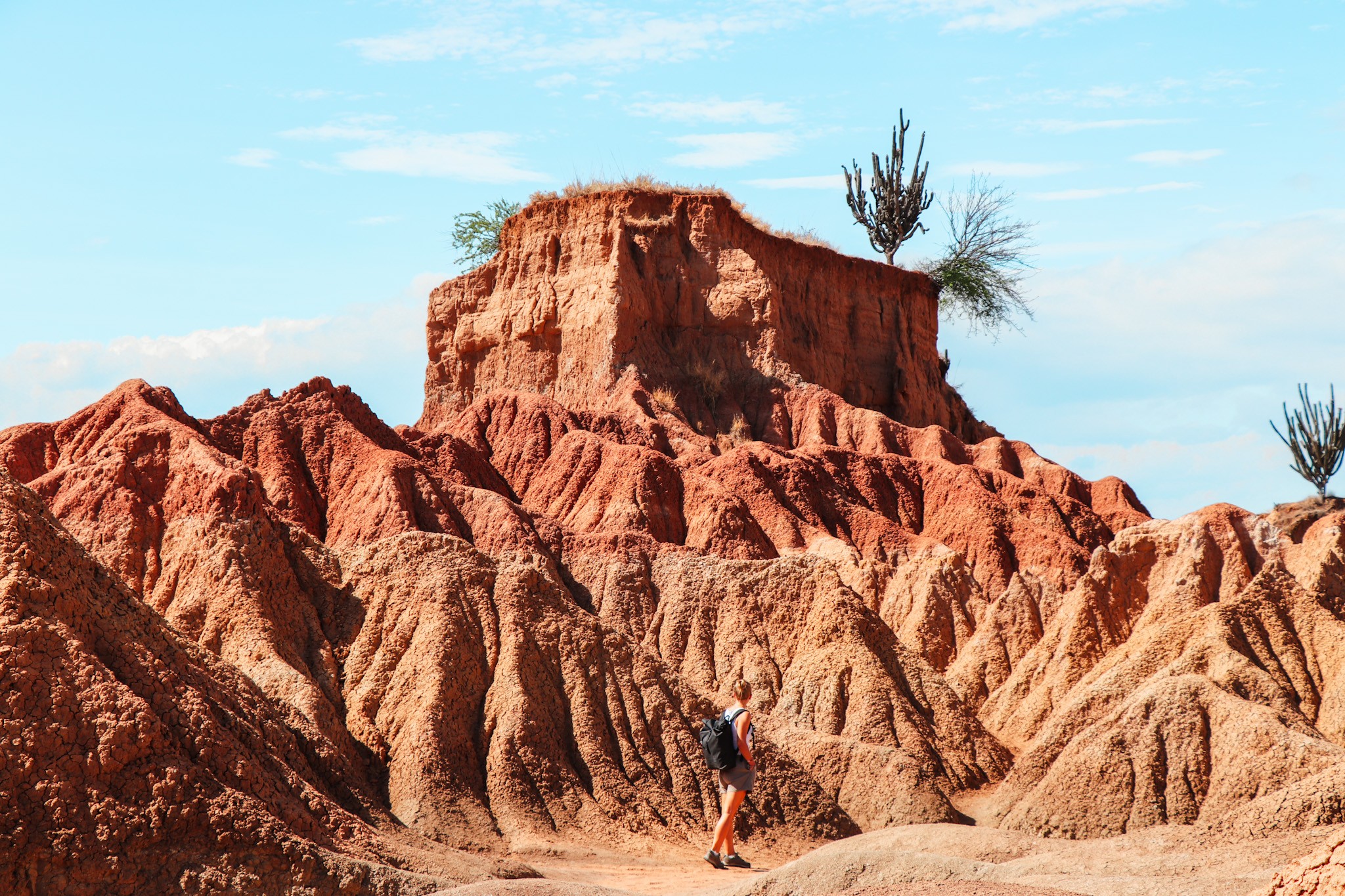
What you need to know about the Tatacoa Desert
Tatacoa rocks - everywhere!
Tatacoa Desert is renowned for its colorful rock formations and deep canyons that have been sculpted over millions of years. With no direct buses or airports nearby, reaching the Tatacoa Desert is not the easiest endeavor. This might explain why it’s still not overly touristy.
However, the effort of getting to the Tatacoa Desert is worth it. Tatacoa treats you to some breathtaking landscapes that will have your camera working overtime. And those who don’t mind the burning sun can embark on short hikes that promise unforgettable experiences.
It is quite baffling how the landscapes can be so different within the Tatacoa Desert with contrasting Red and Grey Deserts both being part of it. So, if you’re up for an off-the-beaten-track adventure and have enough time, the Tatacoa Desert is your destination.
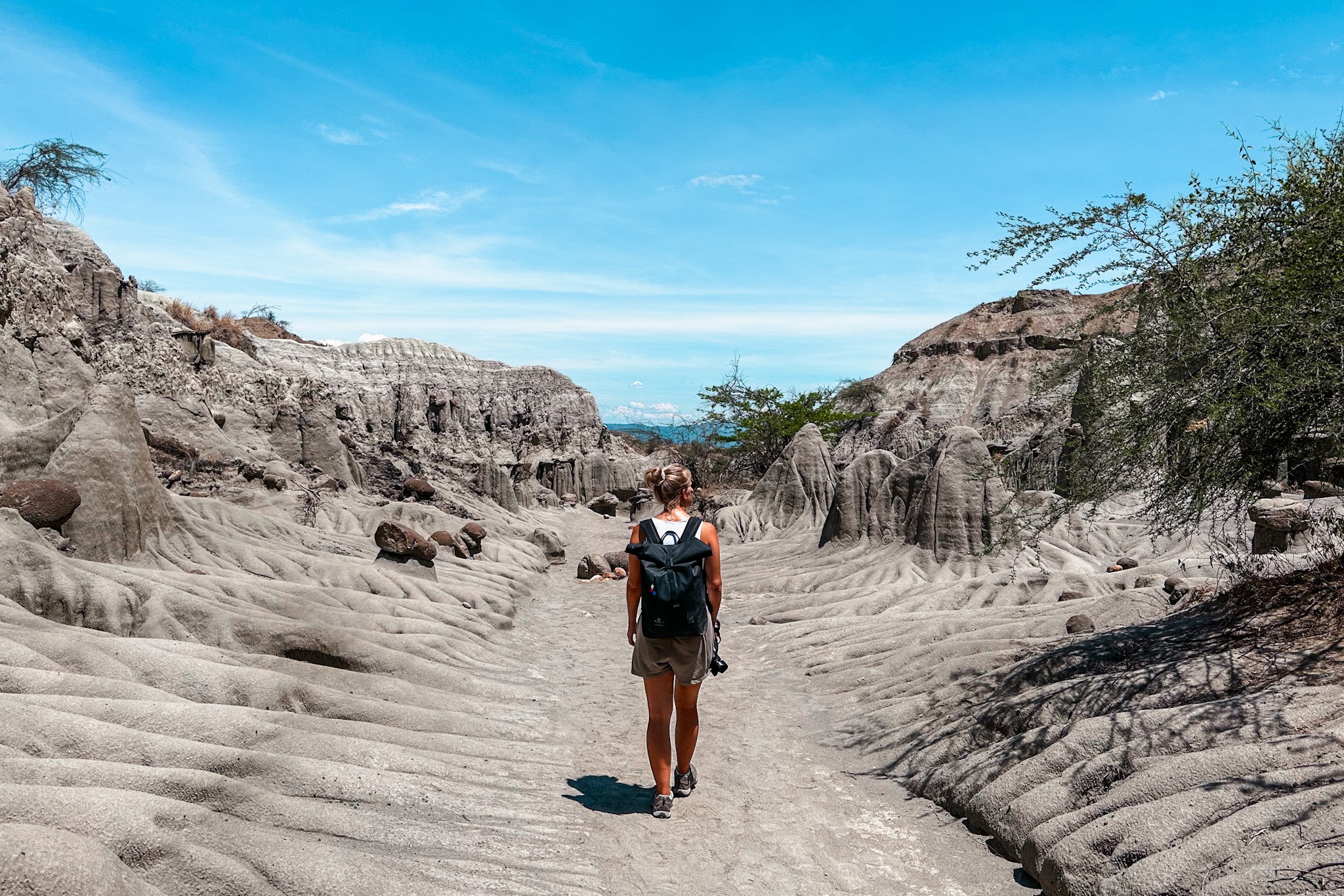
What Tatacoa means - for you
“Tatacoa” is believed to come from the Huila word “tataco,” which is said to refer to a type of rattlesnake found in the area. Even though we haven’t seen a single one while we explored Tatacoa, Rattlesnakes were and still are a part of the desert’s ecosystem, so watch your steps.
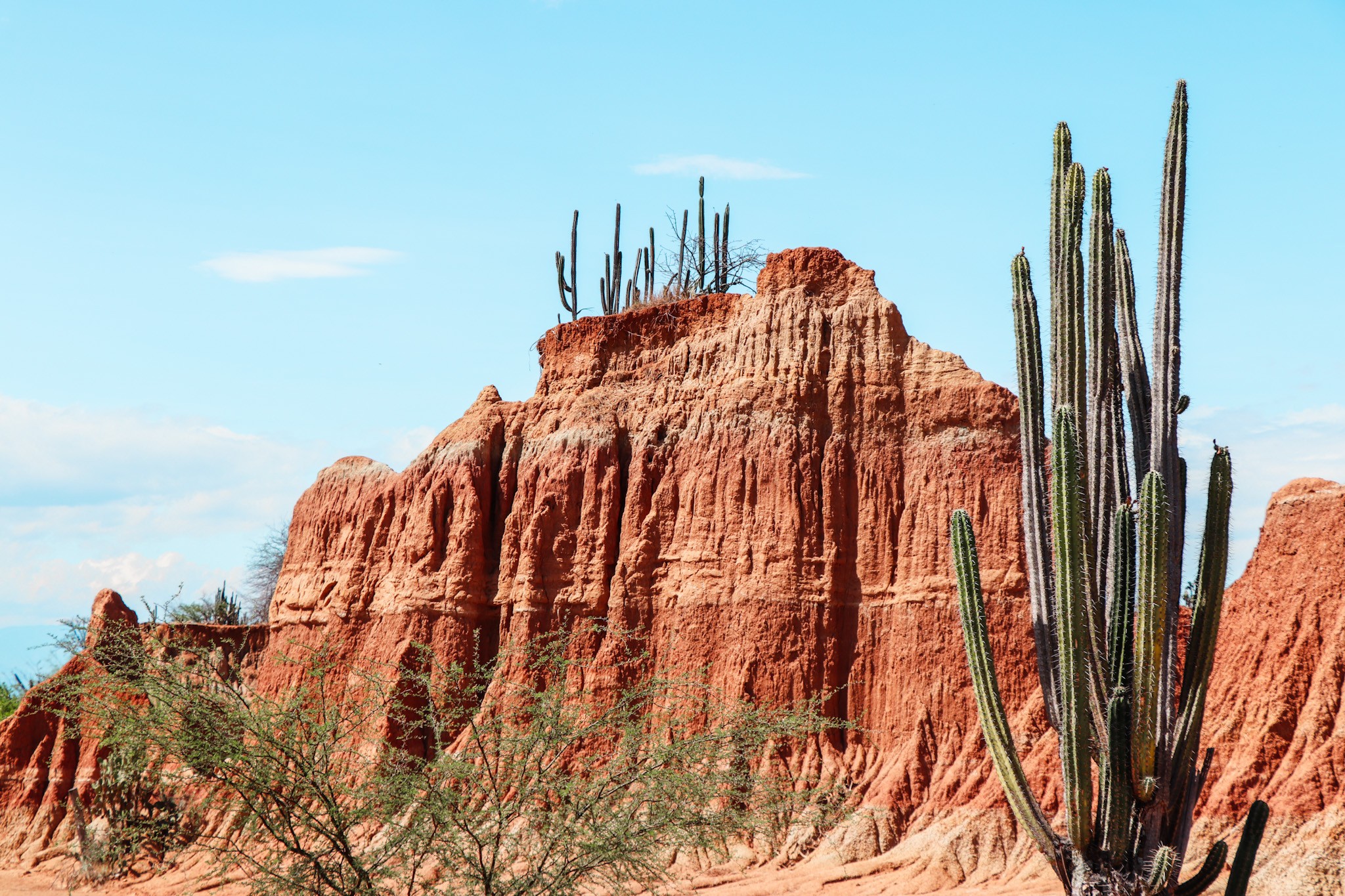
The Tatacoa desert is a lie - it's a forest
“Tatacoa” is believed to come from the Huila word “tataco,” which is said to refer to a type of rattlesnake found in the area. Rattlesnakes were and still are a part of the desert’s ecosystem, so watch your steps.
The Tatacoa Desert is also often referred to as a desert, while technically it’s not. It doesn’t fit the strict scientific definition of a true desert and is officially classified as a “dry tropical forest”.
While Tatcoa may not resemble the definition of a desert, it is no less beautiful. The reason for these crazy rock formations you can expect to see on your Tatacoa trip is the occasional rainfall. They contributed to the formation of these incredible landscapes.
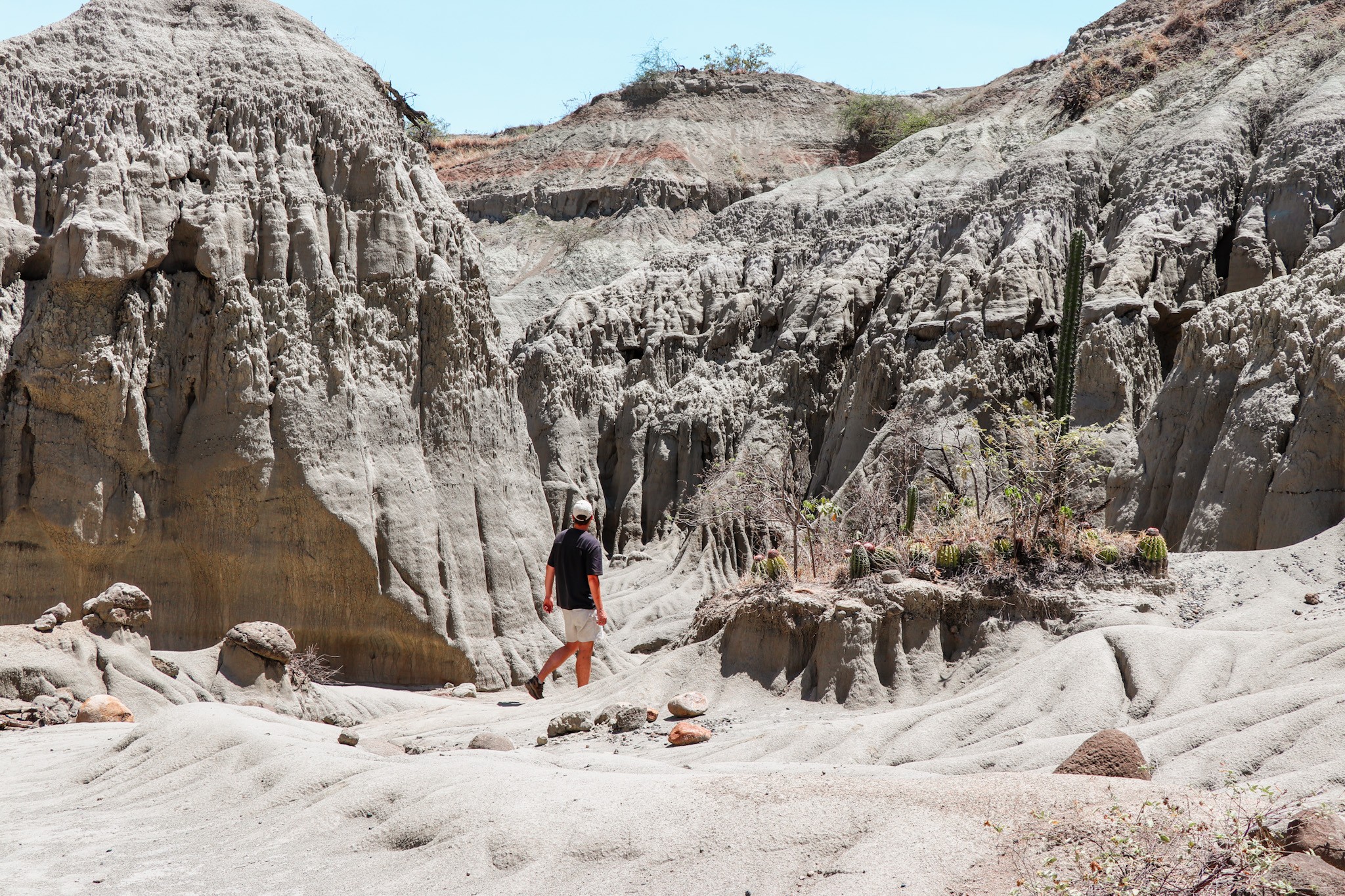
Be careful about when and where you go
Depending on your itinerary and pace, it will take you 2-5 hours to explore the Tatacoa desert. As it gets very hot in the Tatacoa Desert, we recommend planning your visit for early morning or late afternoon. In case you would like to enjoy the sunset in the Red Desert, you should be there around 4 p.m. to allow enough time to explore the labyrinths without feeling rushed.
We’d like to highlight that you should not climb on the delicate walls in the Tatacoa Desert. The soil and rock formations are often very fragile, and climbing can accelerate the natural erosion process. So make sure to not stand at the very edge for your IG selfie.
While visiting the Tatacoa Desert, keep in mind that the terrain can be rugged, so comfortable footwear is a must. Additionally, be sure to bring enough water with you. While there are vendors at the viewpoints, you can expect higher prices there. It’s important to note that you won’t find any places to purchase water directly on the hiking trail.
Best Things to do in the Tatacoa Desert
We visited the Tatacoa Desert after our trip to Salento. Going to the desert was one of our bucket list items when we crafted our Colombia itinerary and it didn’t disappoint. So, we’ve collected the best things you can do while being in Tatacoa.
1. El Cuzco - the Red Desert
El Cuzco, also known as the Red Desert, is like stepping onto another planet right here on Earth. The striking contrast between the vivid red and gray rock formations, that have been shaped over centuries, creates an otherworldly atmosphere.
The Red Desert’s breathtaking landscape is the result of millions of years of geological processes. The striking red coloration comes from the high iron concentration in the soil and rocks. Erosion has sculpted the formations into a maze-like labyrinth of canyons, ridges, and spires. Exploring this geological wonderland is like taking a journey through time, as each layer of rock tells a different story of Earth’s history. The interplay of light and shadow on the red rocks, especially during sunrise and sunset, creates a magical atmosphere.
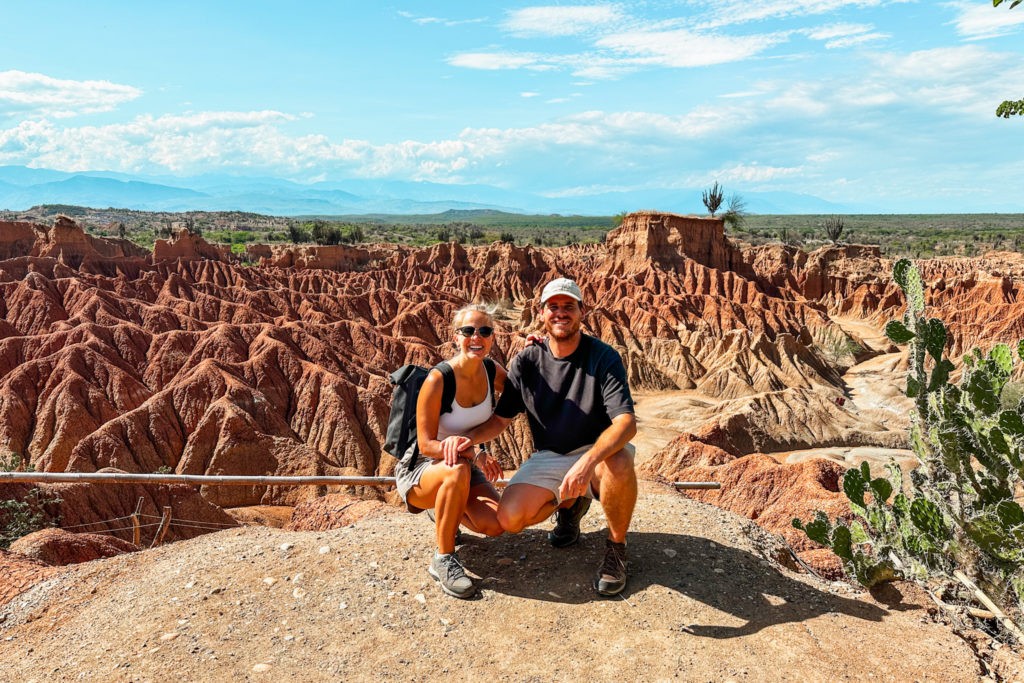
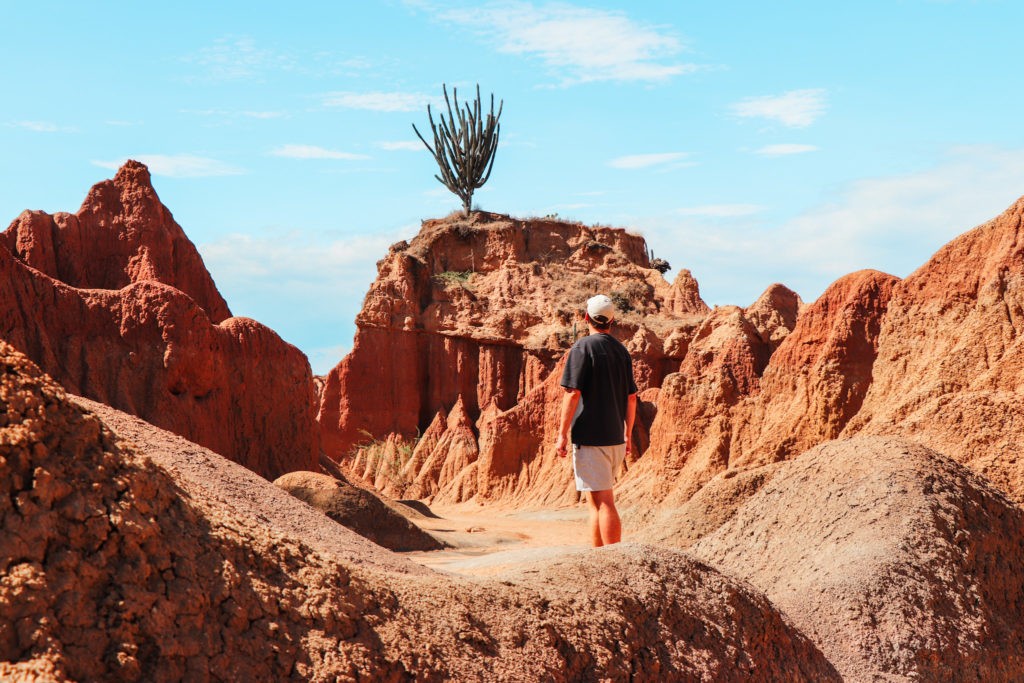
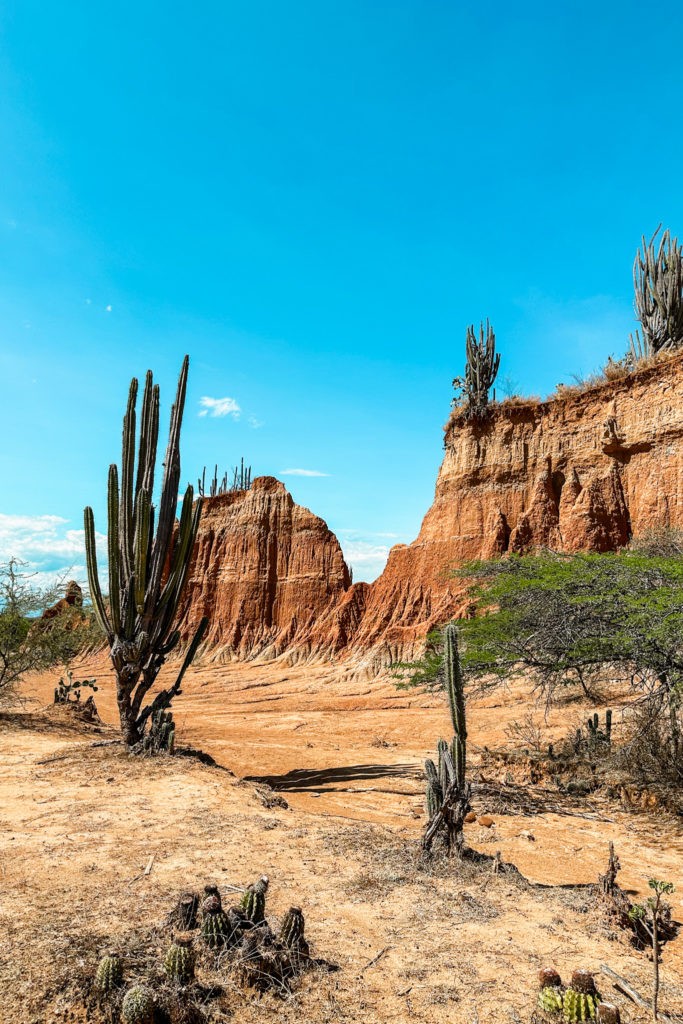
To fully immerse yourself in the wonder of the Red Desert, you’ll start your journey at one of the viewpoints: “Mirador El Cuzco” or “Mirador Laberinto El Cuzco”. These points offer panoramic views of the surreal landscape, making them ideal spots for photographs. The hike into the labyrinth of these unique formations begins here.
The hike is a one-way journey and can be completed in either direction. Your driver will be waiting for you at the opposite end or viewpoint. Depending on your pace and the stops you make for photos and exploration, the hike typically takes around 30 minutes to an hour. It’s an opportunity to get up close to the dramatic geology that defines El Cuzco.
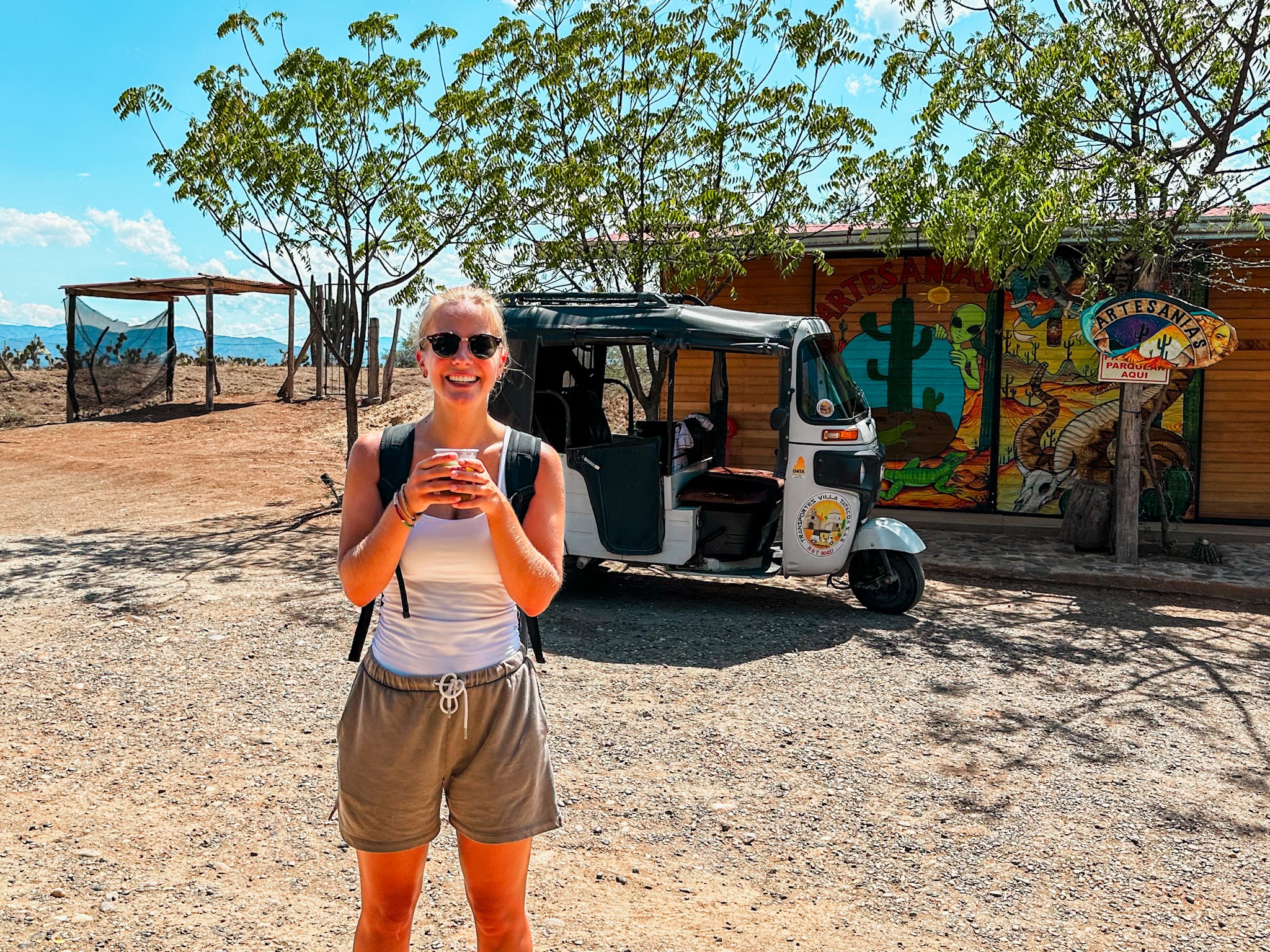
2. Los Hoyos - The Grey Desert
Los Hoyos, known as the Grey Desert, is named for its distinctive gray and silver formations. Although many people seem to like the Red Desert more, we think the two places are completely different and cannot be compared. Therefore, we recommend visiting both.
One of the most fascinating aspects of Los Hoyos is its geological history. The distinct gray tones of the landscape are due to the presence of volcanic ash, offering a striking contrast to its brother the Red Desert.
The best way to explore Los Hoyos is on foot, taking a leisurely hike through its winding trails. The trek is about 40 min to 1 hour long and you will end at the parking lot again. As you hike through this mesmerizing terrain, you’ll encounter a surreal blend of lunar-like landscapes and viewpoints that reveal panoramic views of the Grey Desert’s unique beauty.
At the end of the hiking trail, there’s a pool with a view over the Grey Desert. While it did appear nice when we arrived (many blogs claim the water often appears to be dirty), and it would certainly have been a refreshing experience, we made the choice not to support activities that appear unsustainable to us. The idea of having large pools amid the desert doesn’t seem environmentally responsible. Also, it does ruin the beautiful views of the landscape.
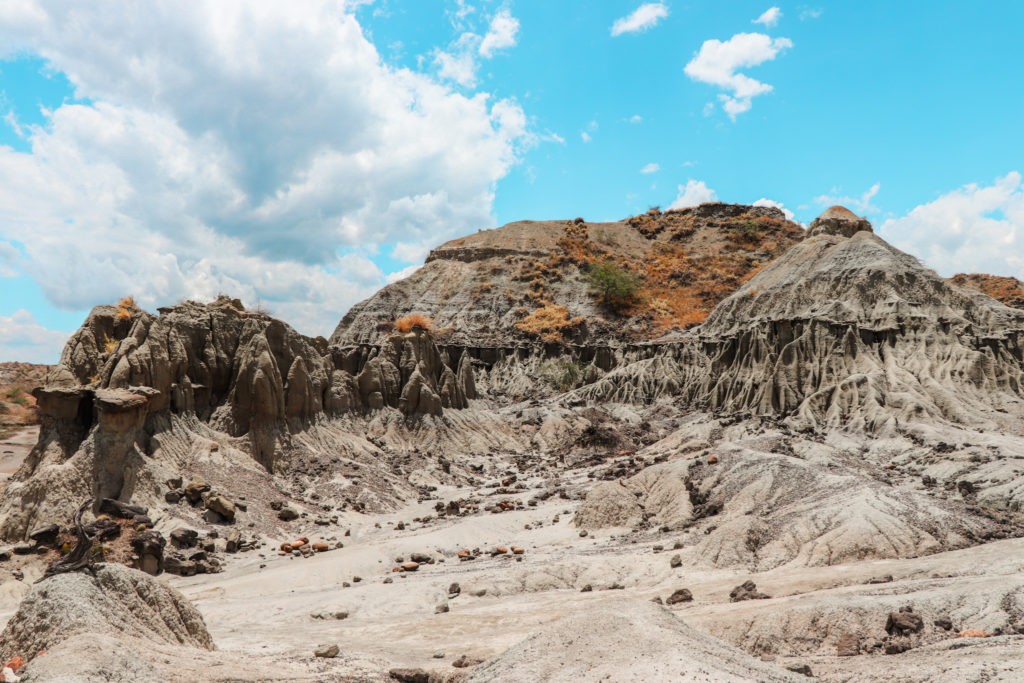
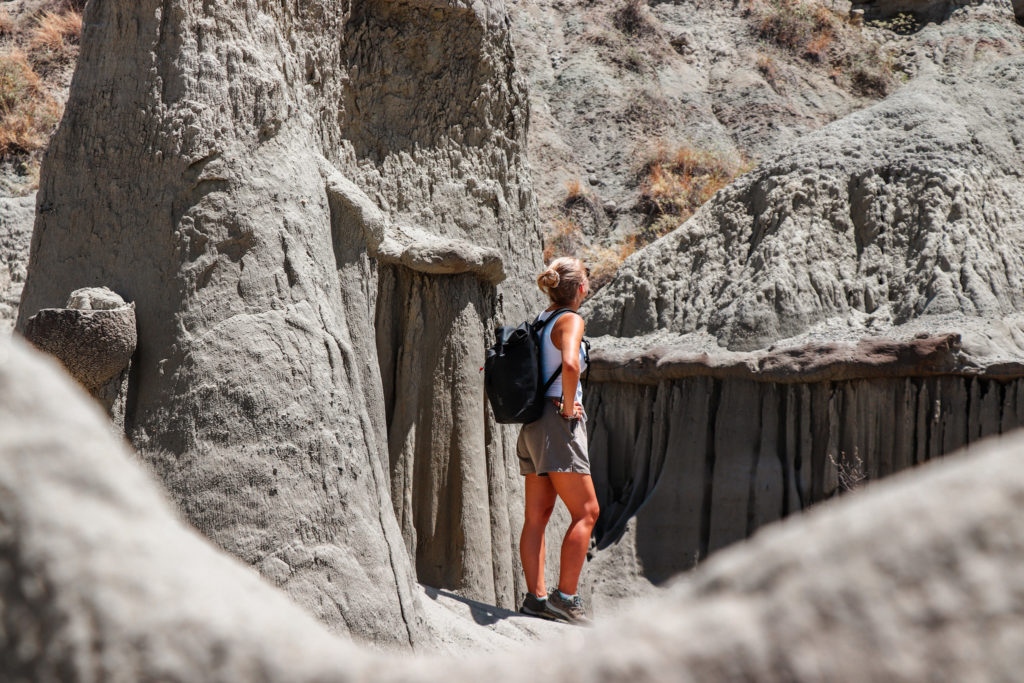
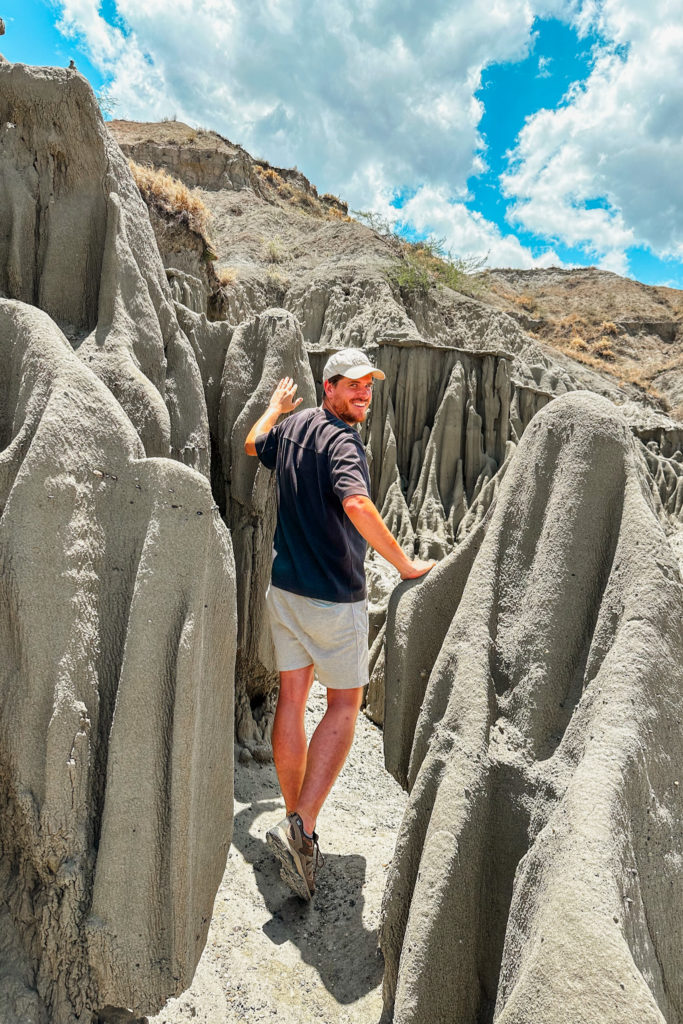
3. Valle de los Xilopalos
The third hike you can do in the Tatacoa Desert is in the Valle de los Xilopalos. This is the furthest away from Villavieja. Also here, the trail starts at a viewpoint. While the rock formations here are not as spectacular as in the Red and Grey Desert, the track offers some fascinating narrow gorges which make the place special.
Also, fewer tourists seem to go there, allowing you to explore the area alone, if you are lucky. Hiking the Xilopalos Trail takes one to two hours.
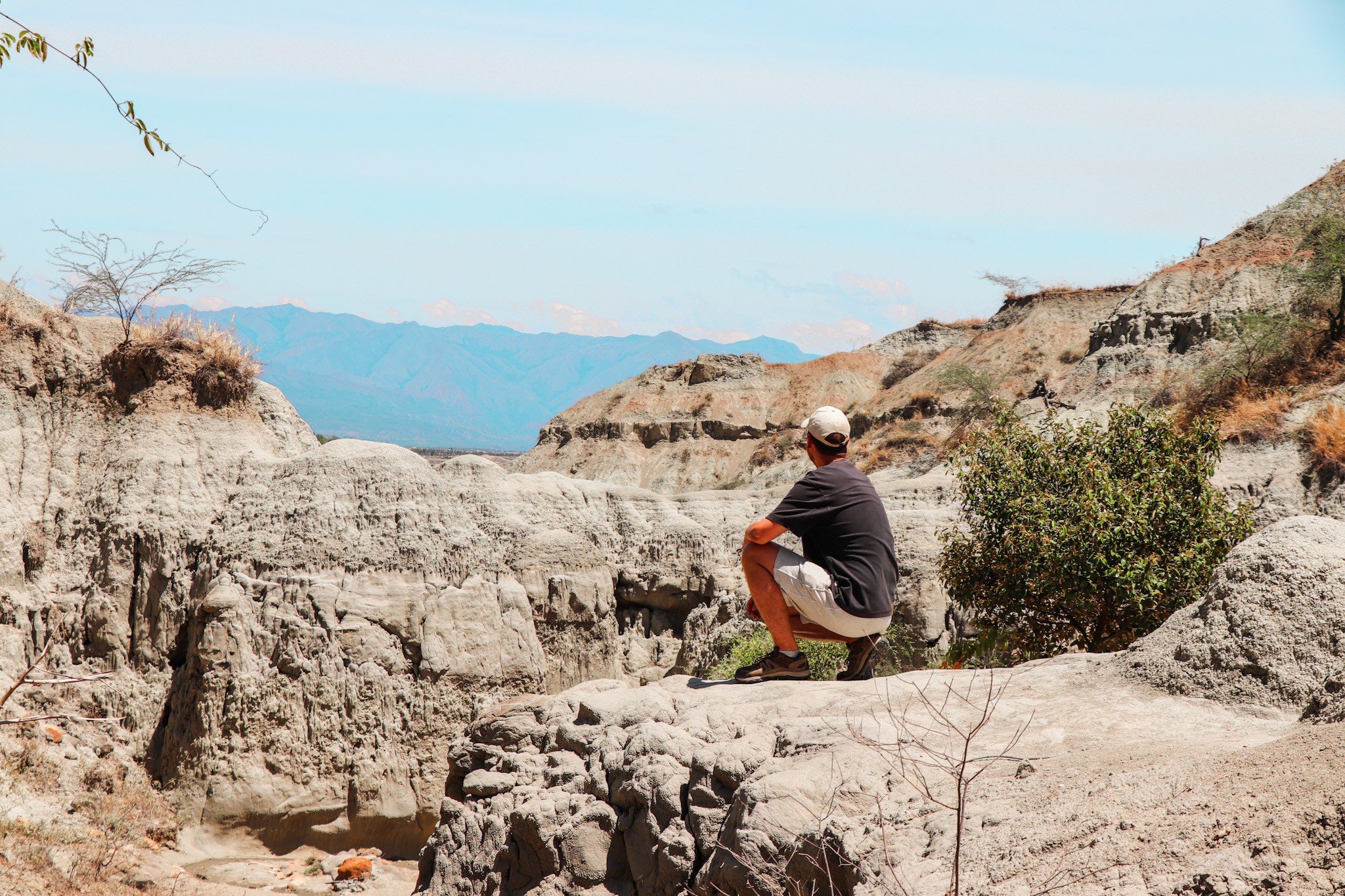
4. Stargazing
The Tatacoa Desert is a fantastic spot for stargazing. With minimal city lights around, the night sky here is a starry spectacle. There are two observatories where you can go for a guided stargazing experience. Both tours include the use of telescopes and informative explanations about the celestial wonders above while lying on a mat under the sky.
- Observatorio Astronomico Astrosur lies in the Tatacoa Desert. While the light pollution is minimal, it only offers tours in Spanish.
- Observatories Astronomico Vyctoriastars is near Villavieja town, which may mean more light pollution. On the positive side, it also has a short 15-minute explanation in English at the end of the stargazing experience.
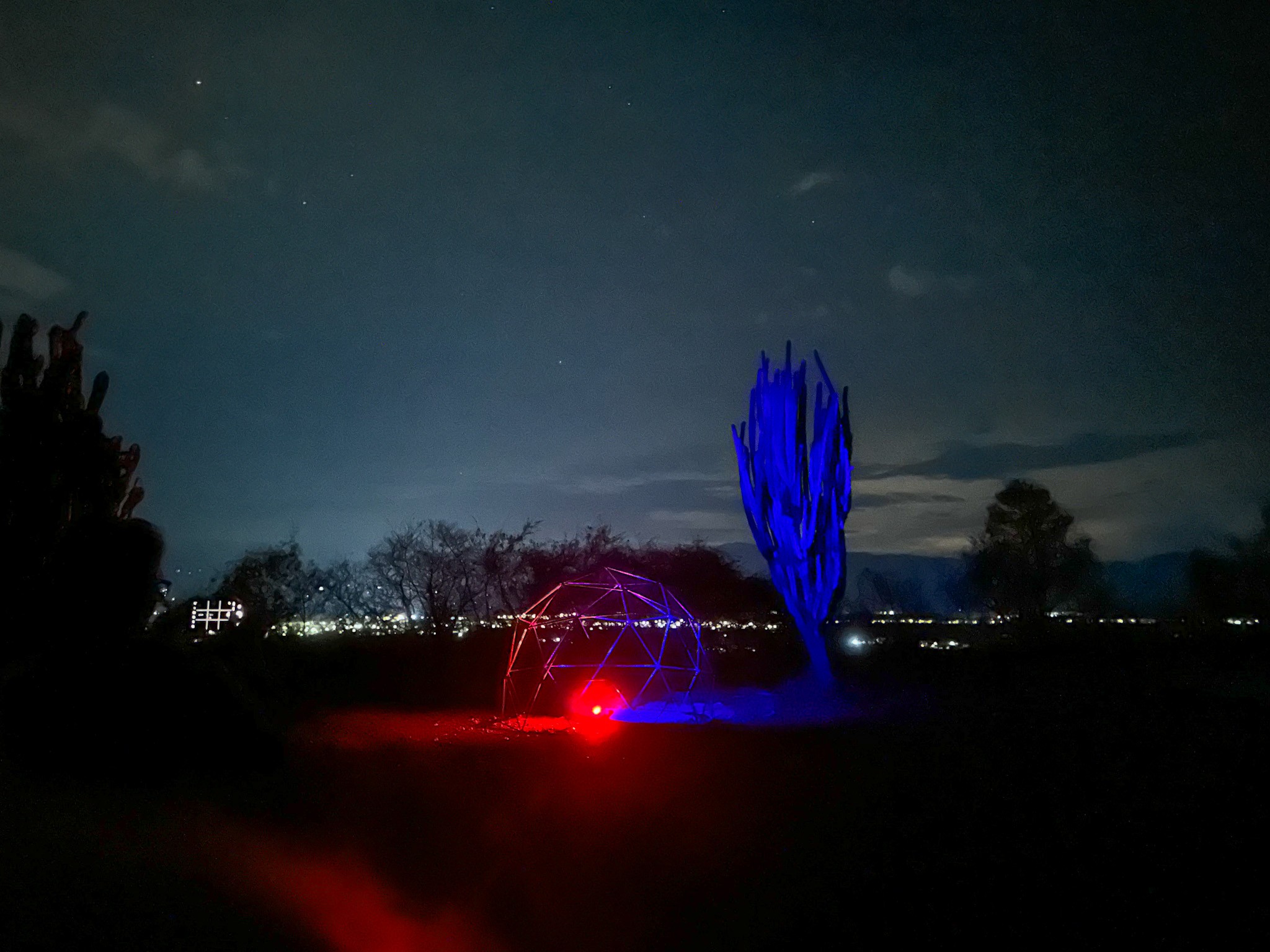
Both tours are affordable, costing only 10000 COP (≈ 2 USD). However, the real cost driver is the tuk-tuk ride there being 30000 COP (≈ 7 USD) per person for a round trip.
The conditions for stargazing are best during moonless nights or the New Moon phase. We were visiting the observatory Vyctoriastars during that time, and were a bit disappointed though. While one could see many stars (we were a bit unlucky with many clouds), the views were nothing to be compared with the night skies of Kenya or Namibia. Maybe we were still too close to the city lights and in the Tatacoa Desert, the experience was more spectacular. Nevertheless, the views on Saturn from the telescope were unforgettable and we got many pictures sent over WhatsApp.
You can and should negotiate the tuk-tuk price when heading to the observatory near Villavieja. The ride is only 7 minutes, but they often quote a higher price, stating that the driver will wait throughout your tour. However, they don’t remain there for the entire duration but return to Villavieja until your tour concludes.
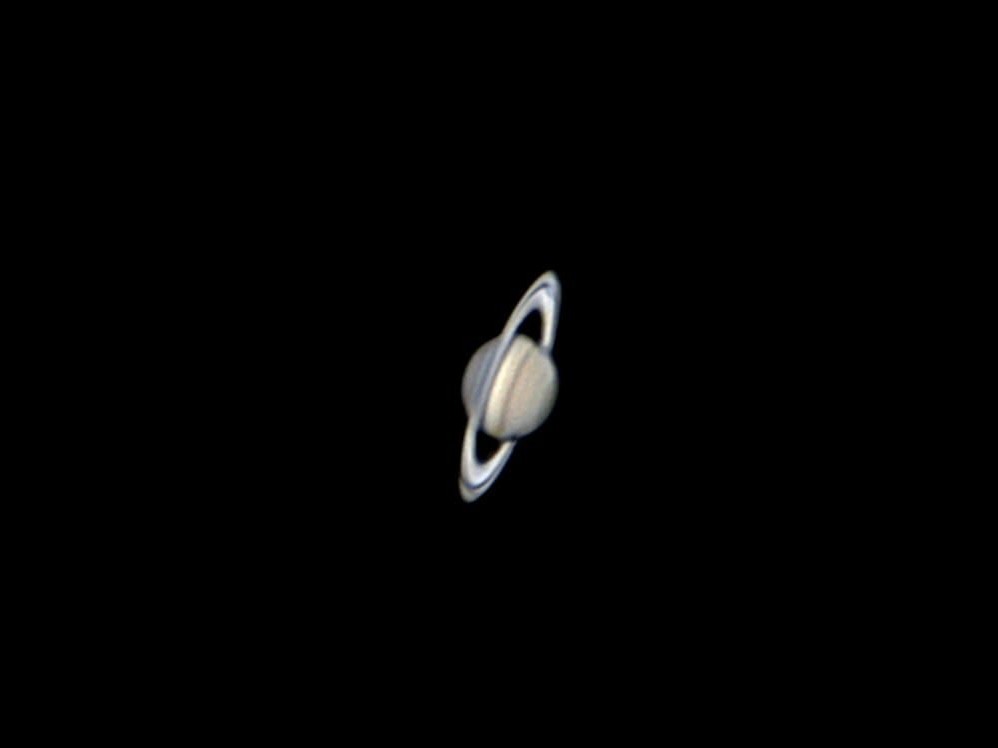
How to get to the Tatacoa Desert?
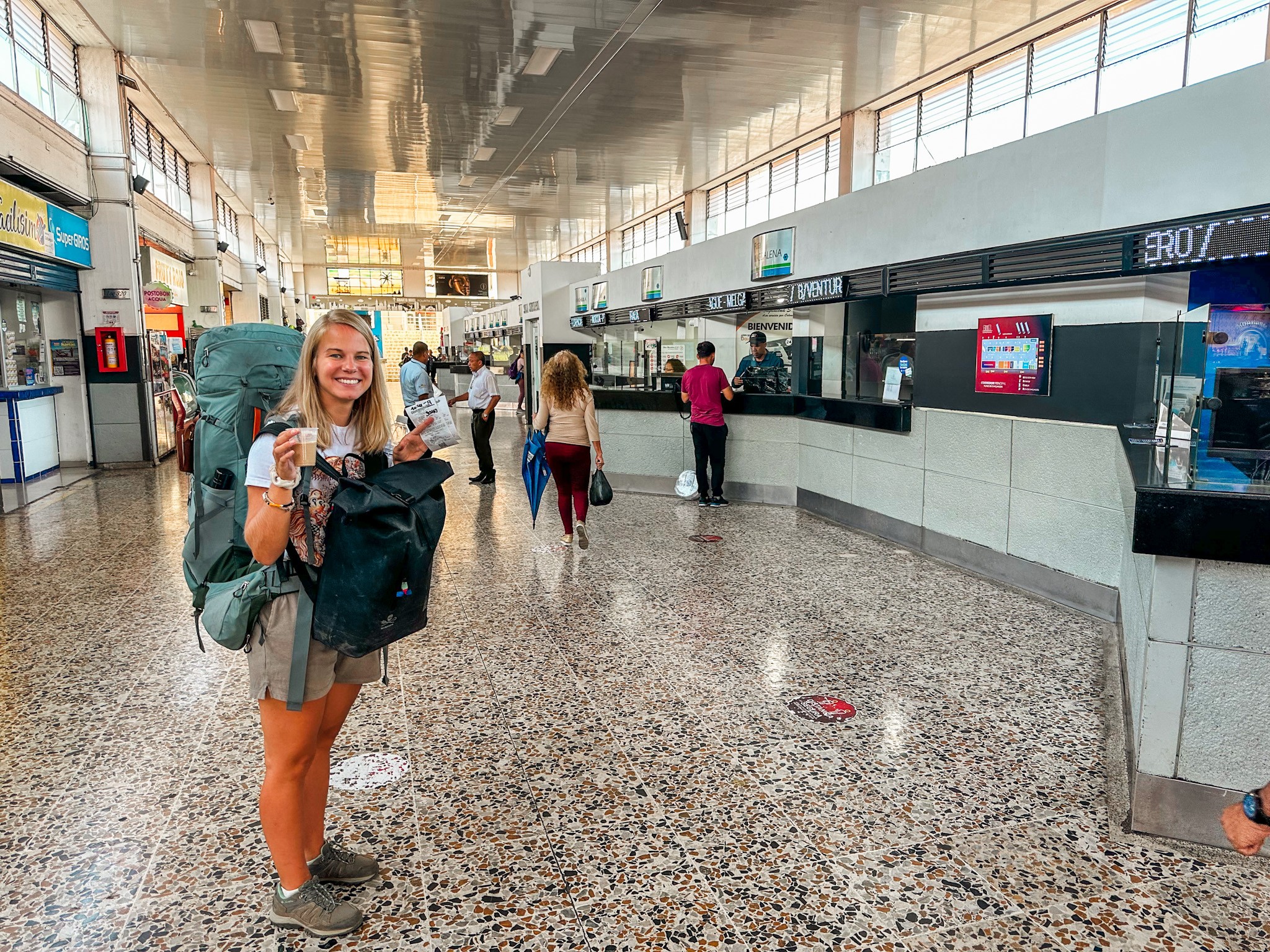
From Salento to the Tatacoa Desert
There is no direct bus from Salento to the Tatacoa Desert. To reach Villavieja, a small village near the Tatacoa Desert you have two options. For both options, you need to travel from Salento to Armenia first. Buses from Salento to Armenia depart every 20 minutes and the ticket costs 6000 COP (≈ 1 USD). The ride takes a good hour to arrive at the Armenia Terminal. The buses may cross through Circasia if there are passengers who wish to exit there.
Once you have arrived in Armenia you can either buy a bus ticket to Neiva and from there take a mini-van to Villavieja or you can choose to drop off already at Aipe. The journey to Aipe takes around 5 to 7 hours, while the ride to Neiva takes around 6 to 8 hours. The tickets to get to Aipe and Neiva can be booked at the counters of Cootranshuila and Coomotor and cost 60000 COP (≈ 14 USD) to 80000 COP (≈ 19 USD).
We would recommend taking one of the buses leaving at 11:00 or 11:15 a.m., to be sure you will catch the last bus from Neiva. Here you can check the current timetables for Cootranshuila and Coomotor online.
If you choose to travel to Aipe, a small village located next to Villavieja on the opposite side of the Magdalena River, you can take a moto-taxi to drive you to the ferry. From there hop on a canoe taxi to bring you directly to Villavieja. While doing so will save you a good 1 – 1.5 hours of travel time, it’s a little less convenient, especially if you have heavy luggage. Make sure to arrive at Aipe latest at 5:15 – 5:30 p.m. as the last river-crossing will be at around 6:00 p.m.
If you choose to travel to Neiva, you can buy a ticket for a local mini-van to Villavieja at the local transfer counters. The ride to Villavieja costs 10000 COP (≈ 2 USD) and takes around 1 hour. Tatacoa Desert is about 15 min away from Villavieja and can be easily visited with a tuk-tuk, costing 30000 COP (≈ 7 USD) to 90000 COP (≈ 22 USD) per person for a round trip, depending on which places you wish to visit.
Relevant Reading
From Neiva to the Tatacoa Desert
In case you decide to stay in Neiva, you can visit the Tatacoa Desert on a day tour. There are two options for that. You can take a local mini-van to Villavieja from the Neiva Bus Terminal. The ride to Villavieja costs 10000 COP (≈ 2 USD) and takes around 1 hour.
From there you can take a tuk-tuk to explore the Tatacoa Desert, costing 30000 COP (≈ 7 USD) to 90000 COP (≈ 22 USD) per person for a round trip depending on your route.
Another option is to get a private taxi or a tour from Neiva to bring you directly to the Tatacoa Desert and back.
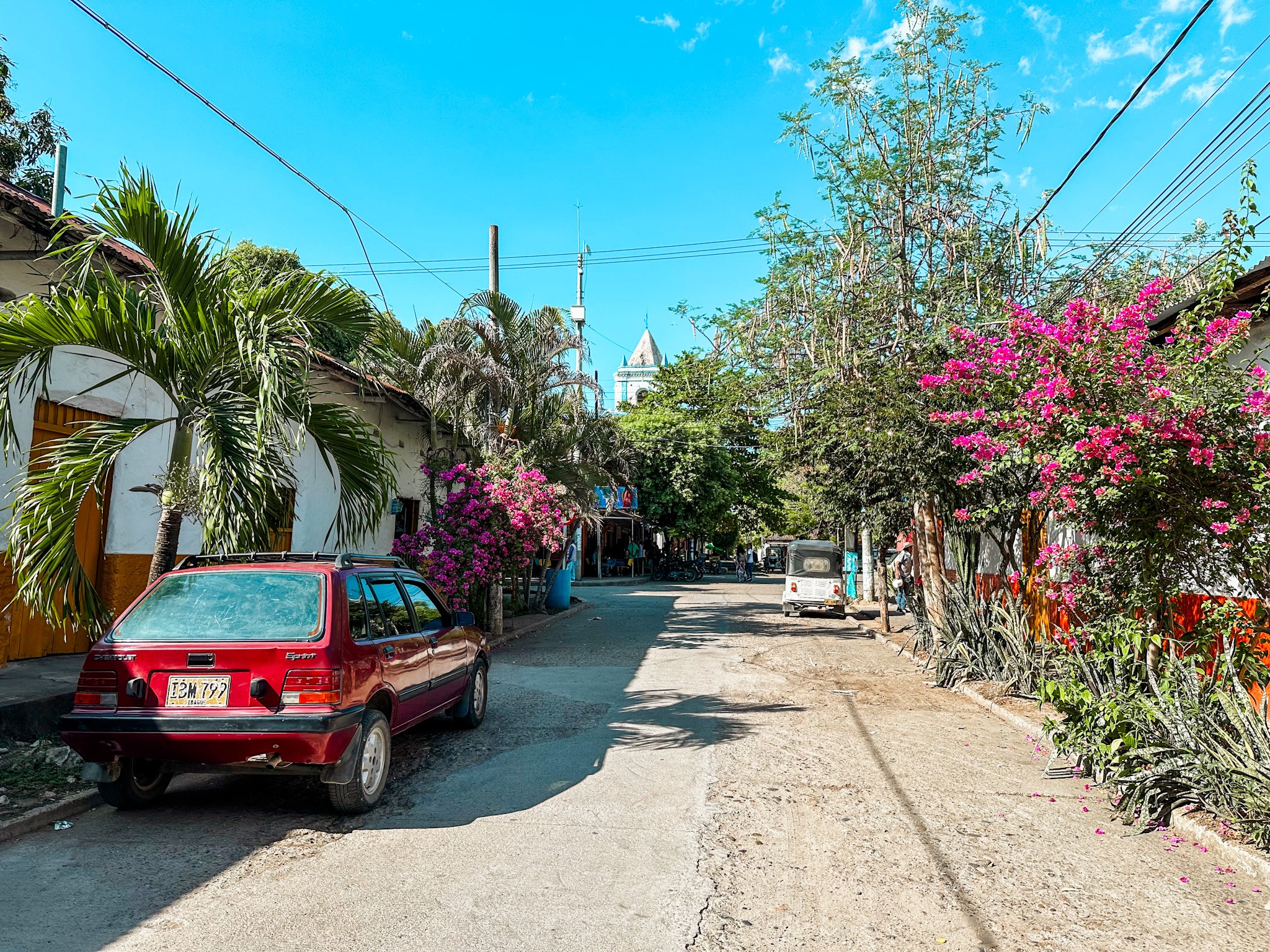
From Bogota to the Tatacoa Desert
There is no direct bus from Bogota to the Tatacoa Desert – also being a reason why it still not so touristy gem of Colombia. To reach Villavieja, a small village near the Tatacoa Desert, you first have to take a bus to Neiva. For this, you will have to go to the Bus Terminal Salitre. There are two bus terminals in Bogota so make sure to go to the right one.
Once in the terminal, look for ticket offices of Cootranshuila and Coomotor. It is important to note that Terminal Salitre in Bogota is enormous, so plan enough time to find the right ticket booth and your bus. The buses leave from Bogota frequently almost around the clock. Here you can check the current timetables for Cootranshuila and Coomotor online. The bus ride from Bogota to Neiva takes 6-8 hours and the ticket costs 60000 COP (≈ 14 USD) to 80000 COP (≈ 19 USD).
We want to highlight though, that the connecting bus from Neiva only operates from 6 a.m. to 7 p.m., so it is important to plan your trip accordingly.
From Neiva, you can buy a ticket for a local mini-van to Villavieja at the local transfer counters. The ride to Villavieja costs 10000 COP (≈ 2 USD) and takes around 1 hour. The Tatacoa Desert is conveniently located just 15 minutes away from Villavieja and can be readily explored using a tuk-tuk. A round trip on a tuk-tuk to the Tatacoa Desert generally ranges from 30000 COP (≈ 7 USD) to 90000 COP (≈ 22 USD) per person, depending on your itinerary.
Relevant Reading
From Cali to the Tatacoa Desert
To reach the Tatacoa Desert from Cali you will first have to take a bus to Neiva. The bus ride takes about 8-10 hours and costs you between 77000 COP (≈ 18 USD) and 90000 COP (≈ 22 USD).
When in the Bus Terminal, look for counters of Coomotor or Bolivariano. As the connecting buses from Neiva will only operate until 7 p.m., it is probably best to take a night bus from Cali to not spend a night in Neiva. You can check the current timetables for Bolivariano and Coomotor online.
Once in Neiva, you can purchase a ticket for a local mini-van to Villavieja at the transfer counters. The journey to Villavieja is priced at 10000 COP (≈ 2 USD) and typically lasts around 1 hour. Tatacoa Desert, conveniently situated just 15 minutes from Villavieja, is easily accessible by tuk-tuk. The cost of a round trip on a tuk-tuk to Tatacoa Desert varies, ranging from 30000 COP (≈ 7 USD) to 90000 COP (≈ 22 USD) per person, depending on your specific travel plans.
Where to stay in the Tatacoa Desert?
There are three options to stay in and around the Tatacoa Desert. You can choose the best place to stay depending on your preferences and available budget.
Tatacoa Desert: In case you would like to enjoy the peace and starry nights in the desert itself, there are options for you from basic tents to lodges for your stay. As said, this also means that you are more dependent on your accommodation
Villavieja: If you are on a budget, staying in Villavieja could be the best option for you. There are several affordable hostels in there but also some more luxurious accommodations.
Neiva: Some people also stay at the nearby city Neiva which is about a 1.5-hour ride away from Tatacoa. While there may be a wider offer of accommodations and restaurants in Neiva, we have also heard that it is not the safest town to stay.
Where to eat in the Tatacoa Desert?
In case you are staying in Villavieja, there are several restaurants and cafes in the town to get some food. We enjoyed the Restaurante Salsipuedes. Also, we recommend trying out some local beer at La Planta Brew Pub Tatacoa. The beer with cocoa was really special. For some coffee and snacks, you can go to Cafe Mael. As Villavieja is a really small town, the prices are fair (except for the water in the shops).
In case you have booked your accommodation in the Tatacoa Desert you are rather dependent on your hostel/hotel as depending on where you are staying there may not be many restaurants around. This can also mean that the accommodation is taking a use of the situation and charges higher prices for meals.
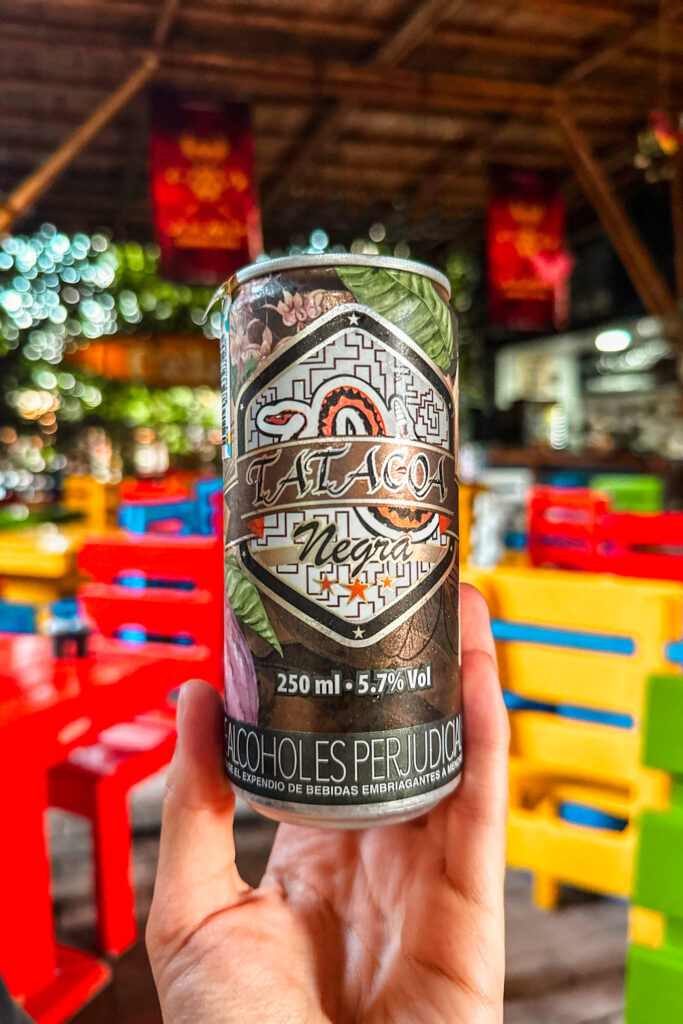
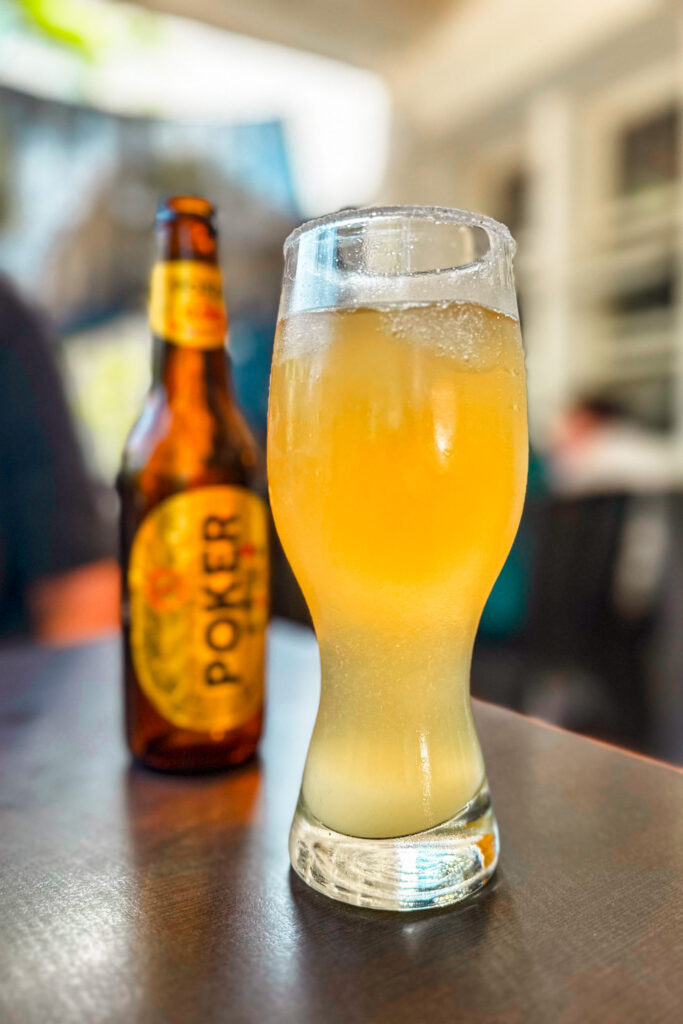
How to get around in Villavieja and the Tatacoa Desert?
Villavieja is a very small town, so you can easily walk to any destination within it. However, if you’re planning to visit the Tatacoa Desert, you’ll need to take a short 15-minute ride. There are several options available for visiting the Tatacoa Desert from Villavieja.
Take a Tuk-Tuk
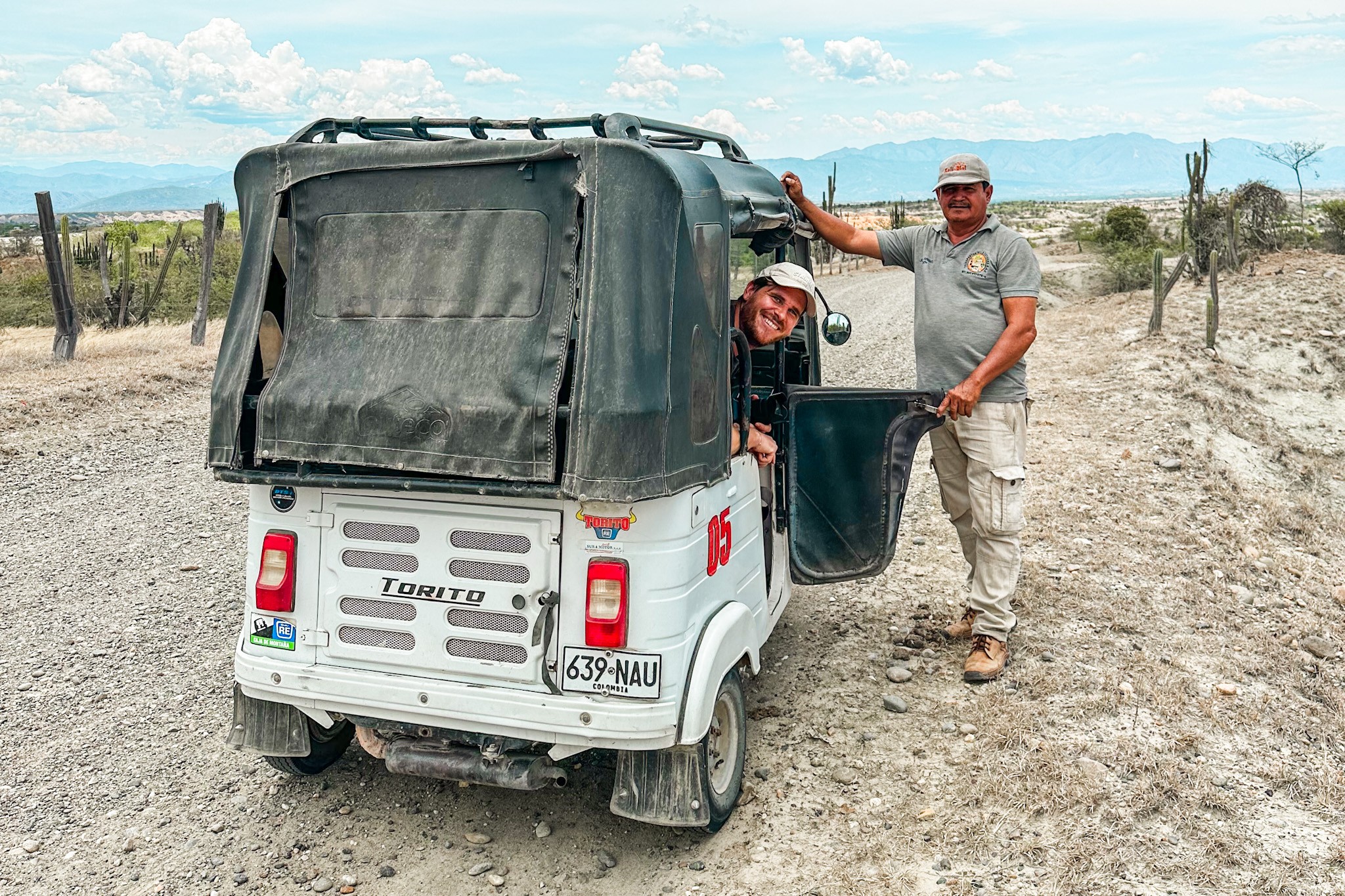
Traveling to both the Red and Grey Deserts costs 60000 COP (≈ 14 USD). This fee covers a 2-4 hour tour, during which the driver will take you to the viewpoints and wait for your return from the hike. If you’d like to include a visit to the Xilopalos trail, there is an additional charge of 30000 COP (≈ 7 USD) per person.
We’ve also heard that there are tuk-tuk drivers in Villavieja who speak English and can provide you with a private guided tour. If you’re interested in learning more about the area and its attractions, you can inquire about this option.
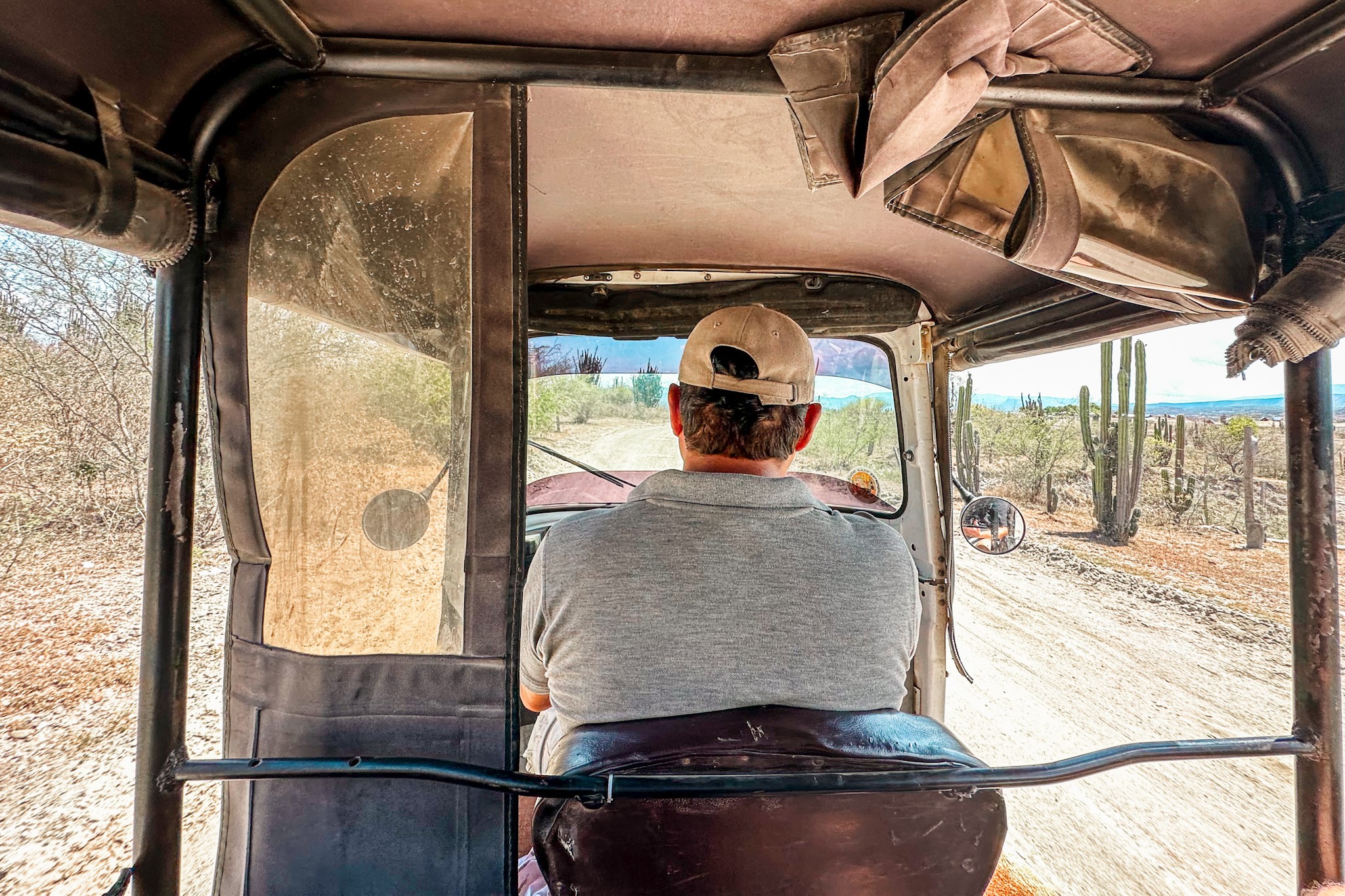
Take a Guided Tour
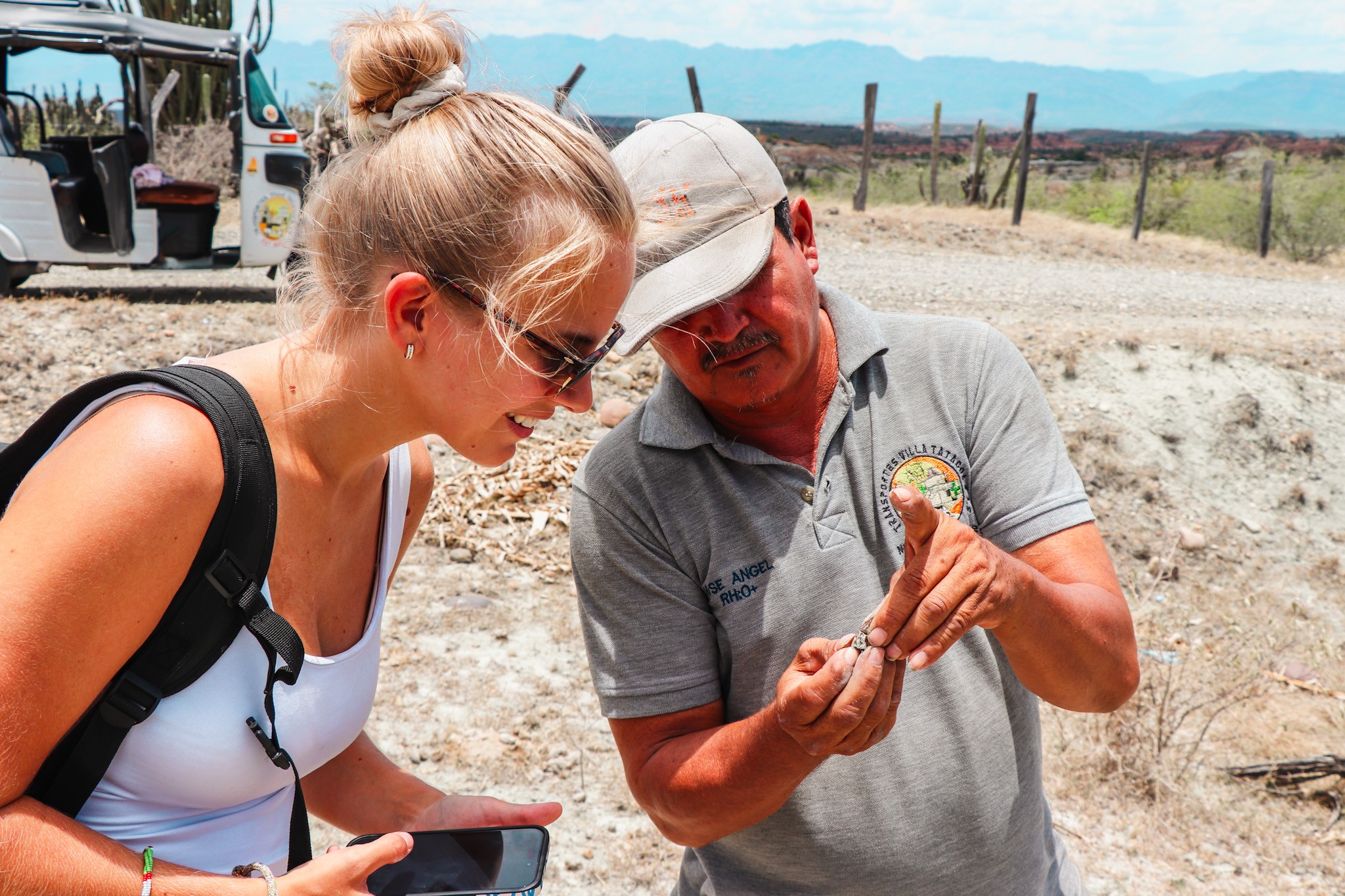
When is the best time to visit the Tatacoa Desert?
The best time to visit the Tatacoa Desert is during the dry season between December and March and during the wet season between June and August when rainfalls are rare and skies are clear. As common for deserts, temperatures during the day can be extremely hot, while at night they drop significantly. Expect temperatures around 33°C – 35°C (91°F – 95°F) during the day and 5°C – 15°C (41°F – 59°F) at night.
We visited the Tatacoa Desert in September and we were melting in the sun. Having that said, we’ve had a good time while at the Tatacoa Desert. So, if you can cope with high temperatures it’s definitely no issue traveling to Tatacoa all year round.
What does it cost to visit the Tatacoa Desert?
Accommodation in the Tatacoa Desert is very budget-friendly and affordable. You can find cheap private rooms for as low as 15 USD and decent food for 5 USD a meal. However, there is not too much luxury in the desert. Most accommodations in Villavieja and the Tatacoa desert are tented camps or small huts with shared bathrooms. So, don’t expect to lodge like a king.
Expect to pay around 200 USD a week if you travel budget up to a maximum of 1000 USD a week if you are after every activity and the most luxury stays.
How many days to stay in the Tatacoa Desert?
We’ve been to the Tatacoa Desert for 3 nights and had 2 full days to explore the area, which we would also recommend. Spend the first day relaxing from your travel day to Tatacoa, explore Villavieja, have some good meals, and go some stargazing at night. On the second day, get up early to visit the Tatacoa Desert and spend your second night inside the desert.
While there are not a ton of things to do around the area of Tatacoa and Villavieja, we think it’s a perfect adventure trip to some of the remote, yet safe areas of Colombia.
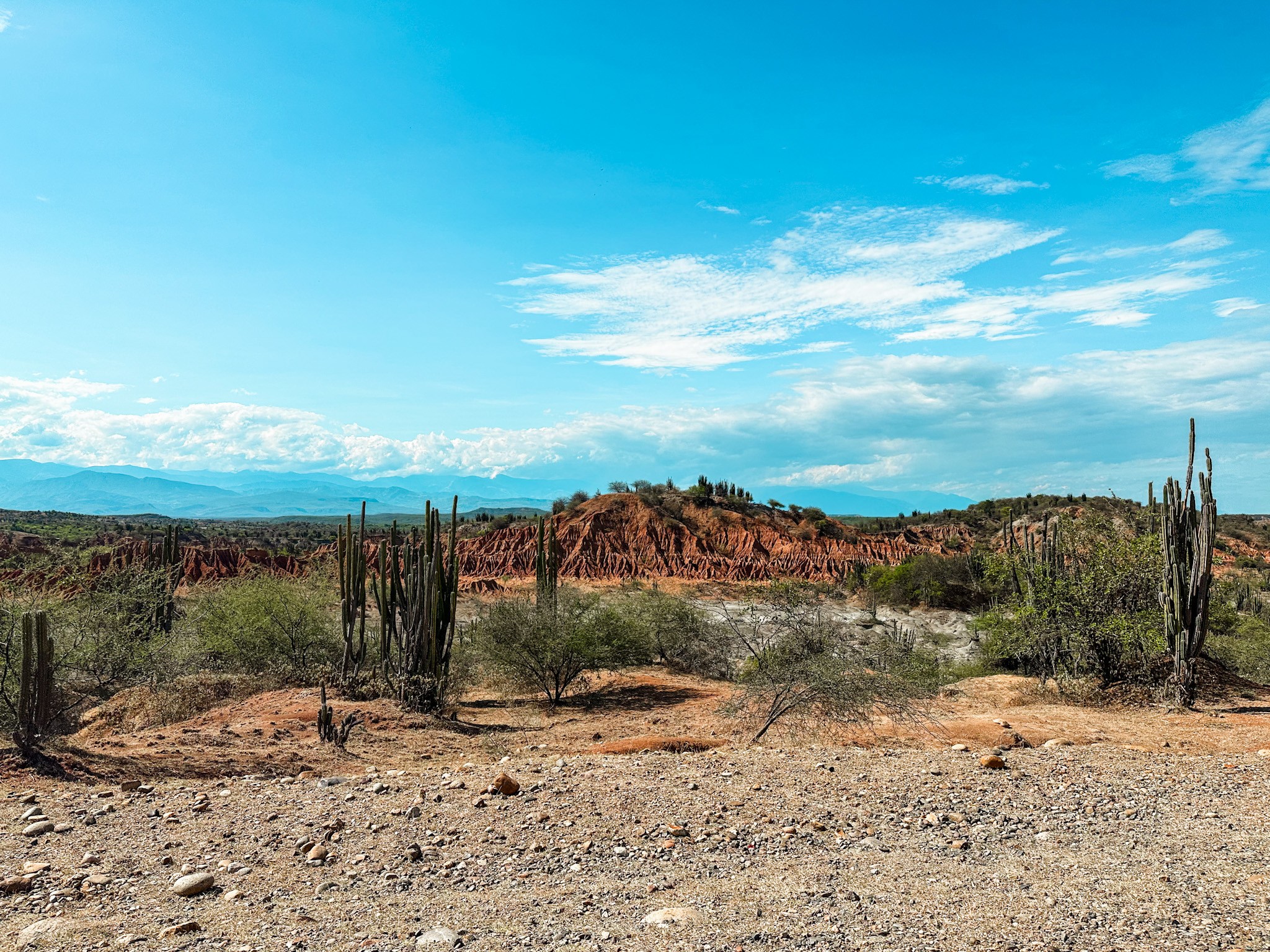
Is visiting the Tatacoa Desert worth it?
Yes, it is! Even though it’s a little adventure to get there, we think that you will have a great time. There is no other desert in the country that is as beautiful as Tatacoa and it is still one of the best-kept secrets of Colombia. It seems like the Tatacoa Desert has not yet been discovered too much by tourism.
During our stay in September, we only saw a handful of foreign tourists. The locals are super friendly and not used too much to tourism yet, which makes the trip to the Tatacoa Desert an authentic experience. Moreover, the Tatacoa Desert is not the typical desert you would expect, which makes it a unique landmark. We’ve had so much fun exploring El Cuzsco (Red Desert) and Los Hoyos (Grey Desert) and getting lost in the maze of sand formations. And if you’re lucky, you’ll see crystal clear skies. So if a little adventure is something that you look for when traveling through Colombia, then the Tatacoa Desert won’t disappoint.

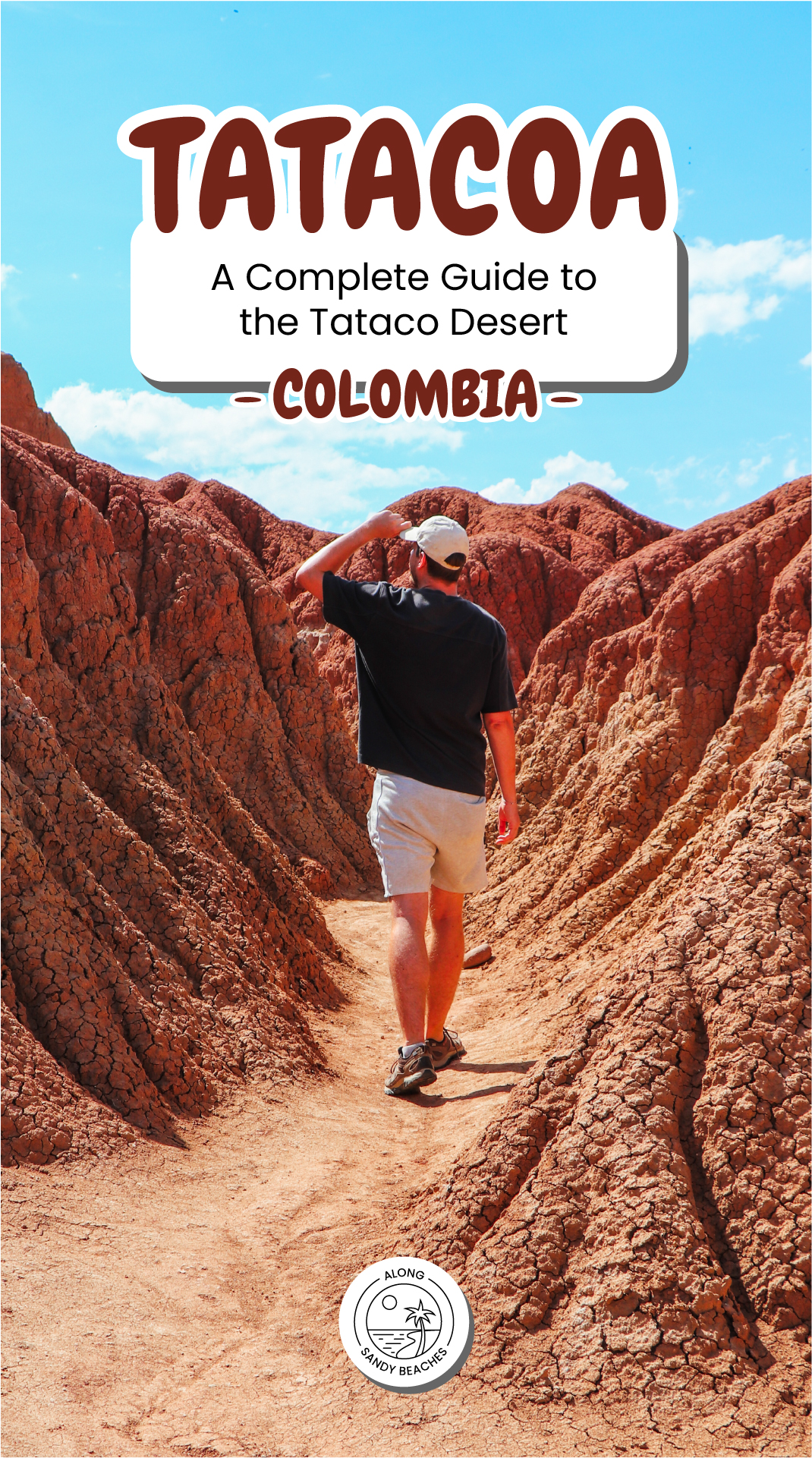
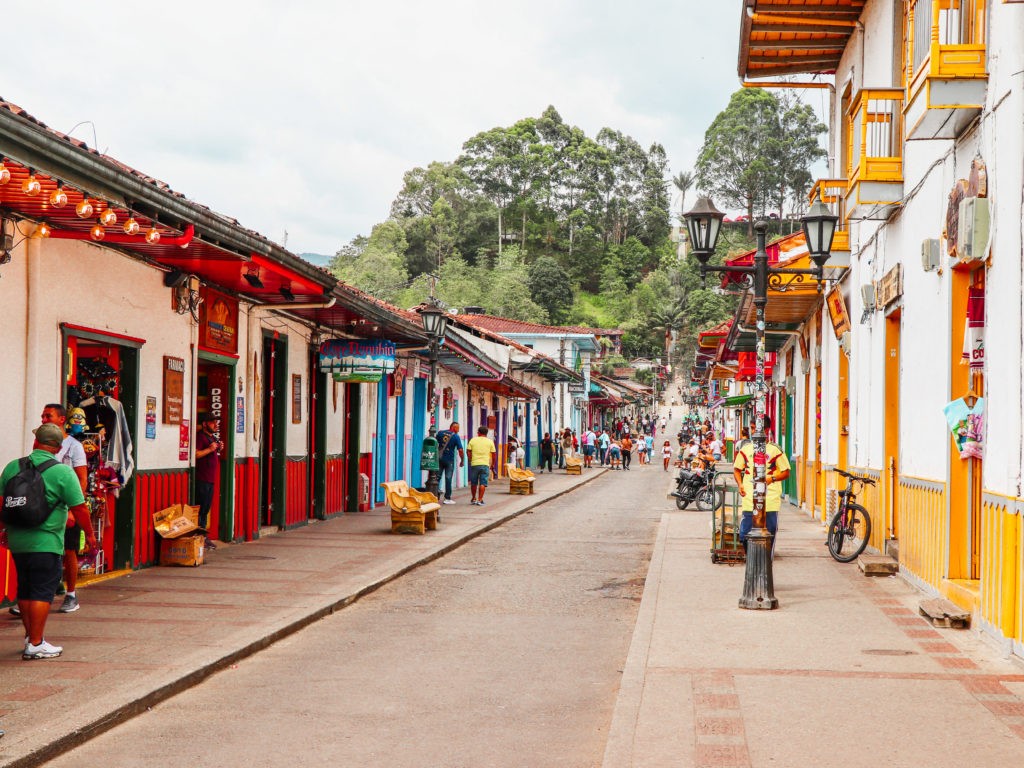
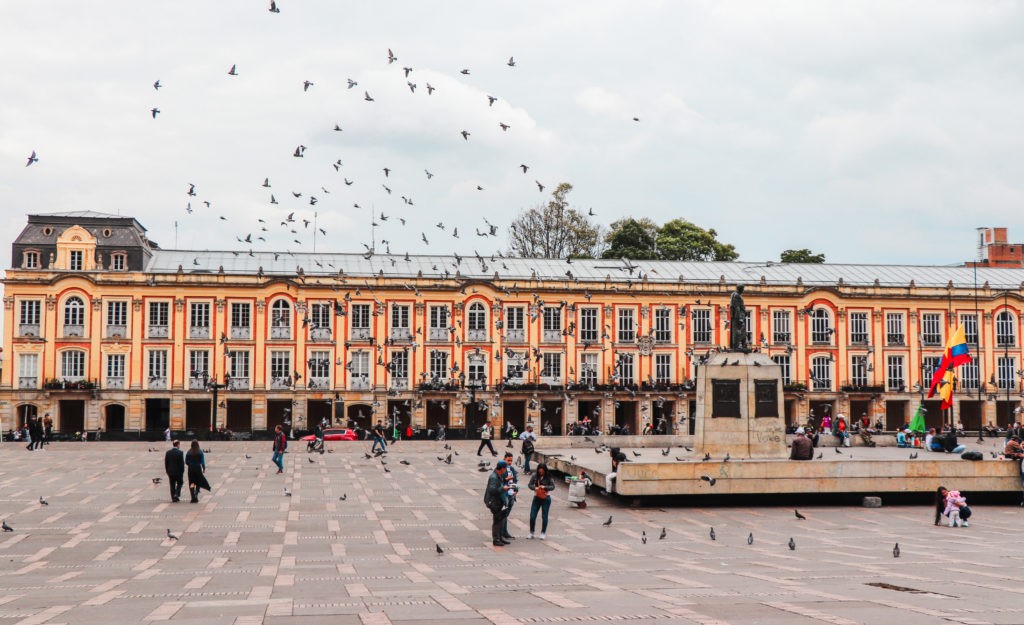
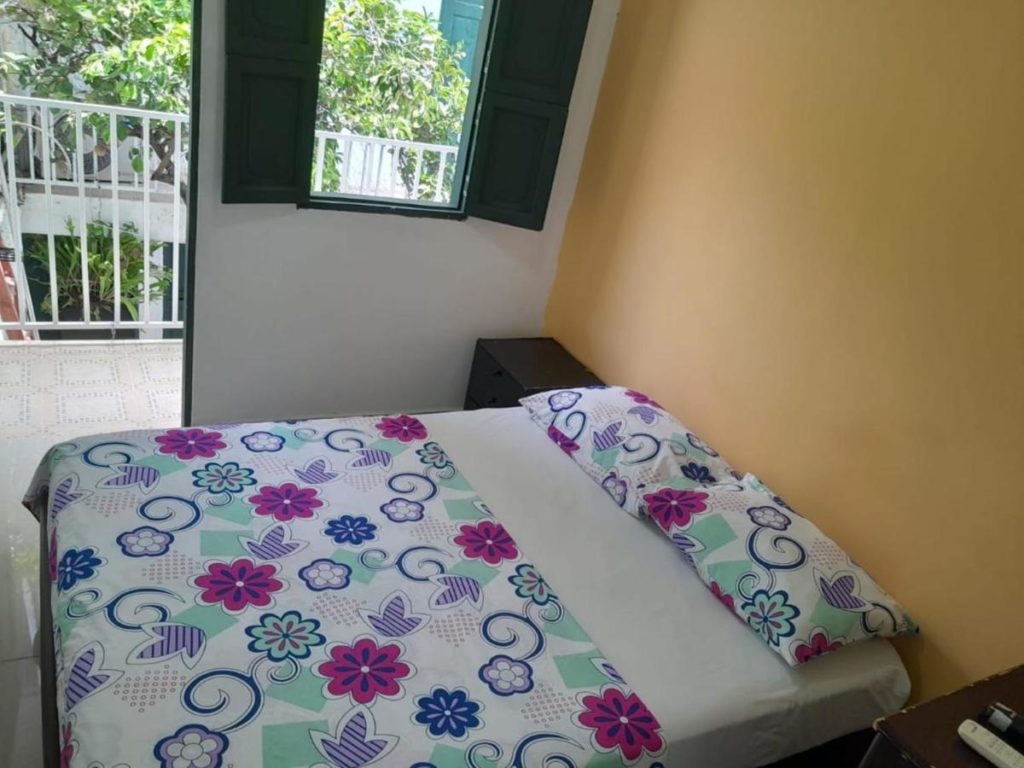
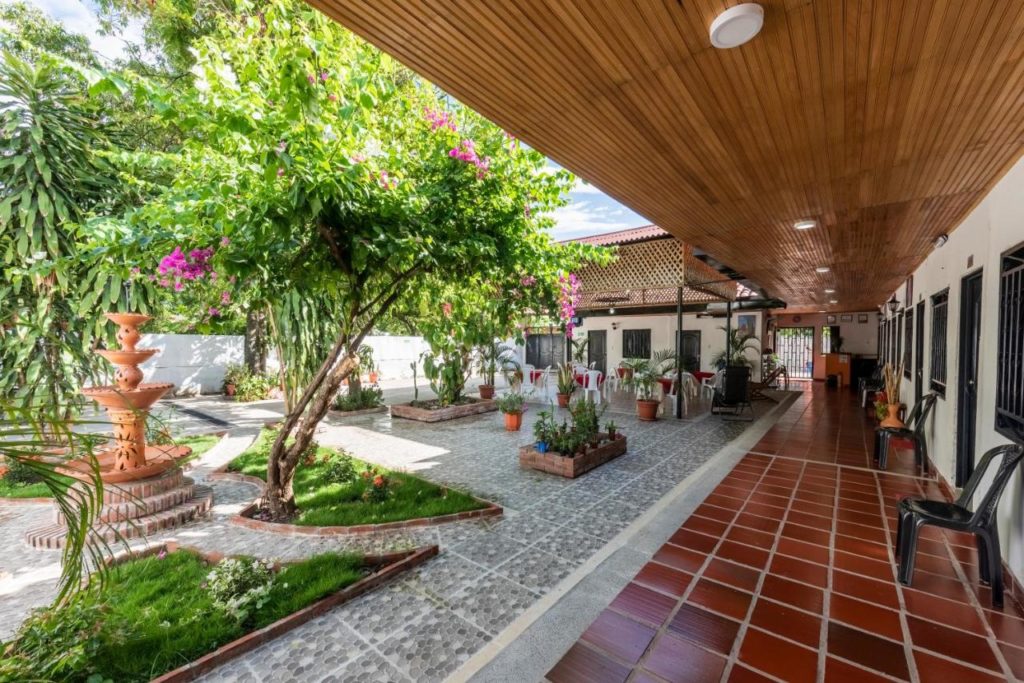
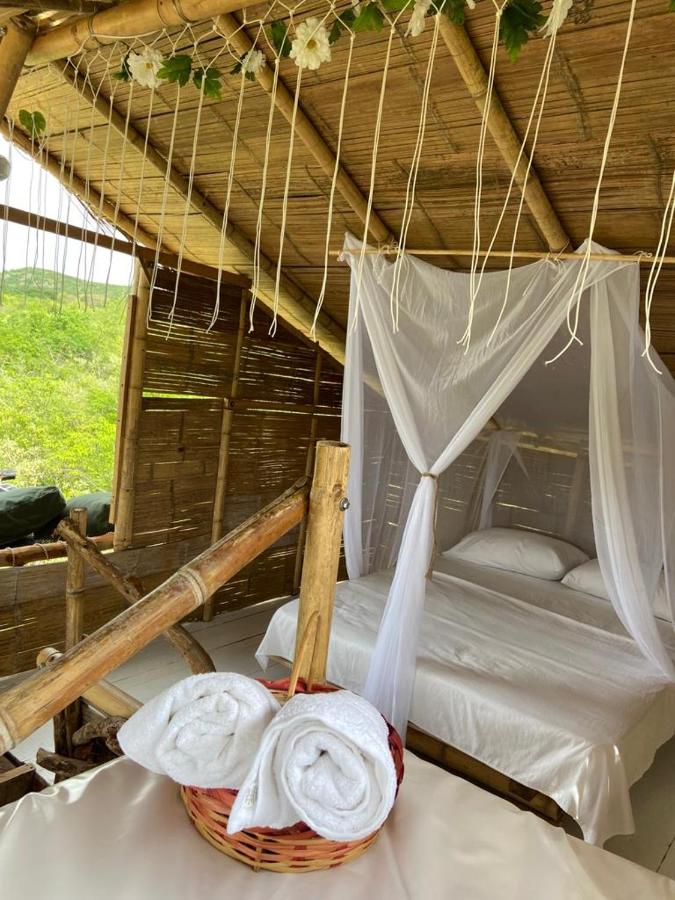
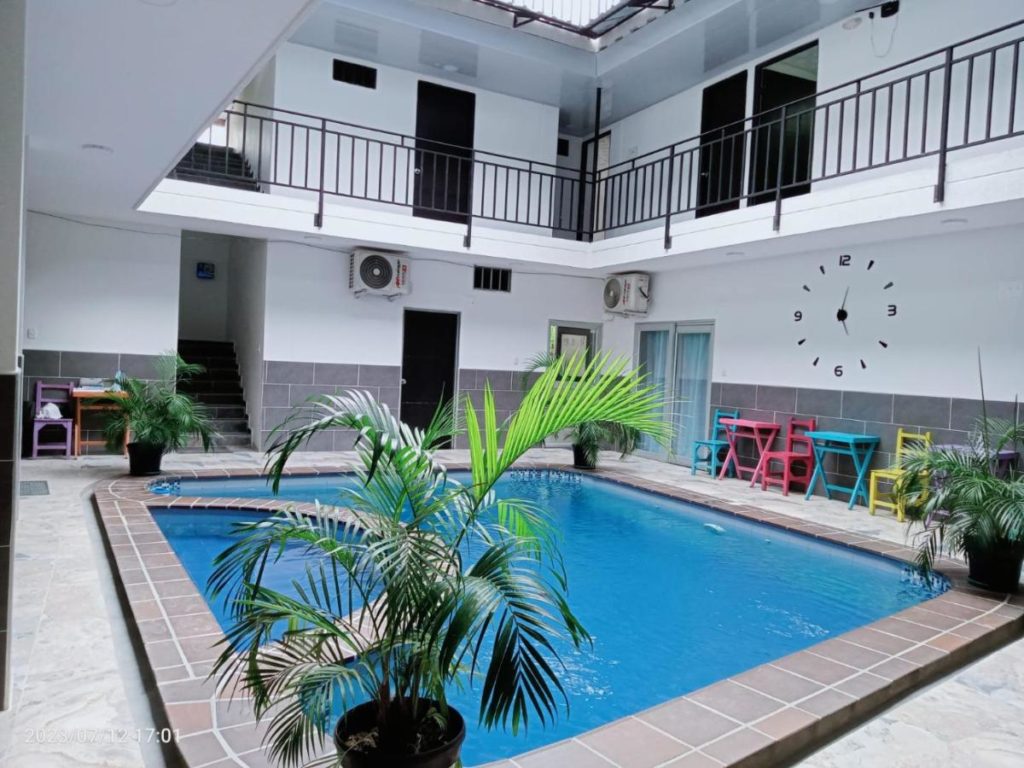
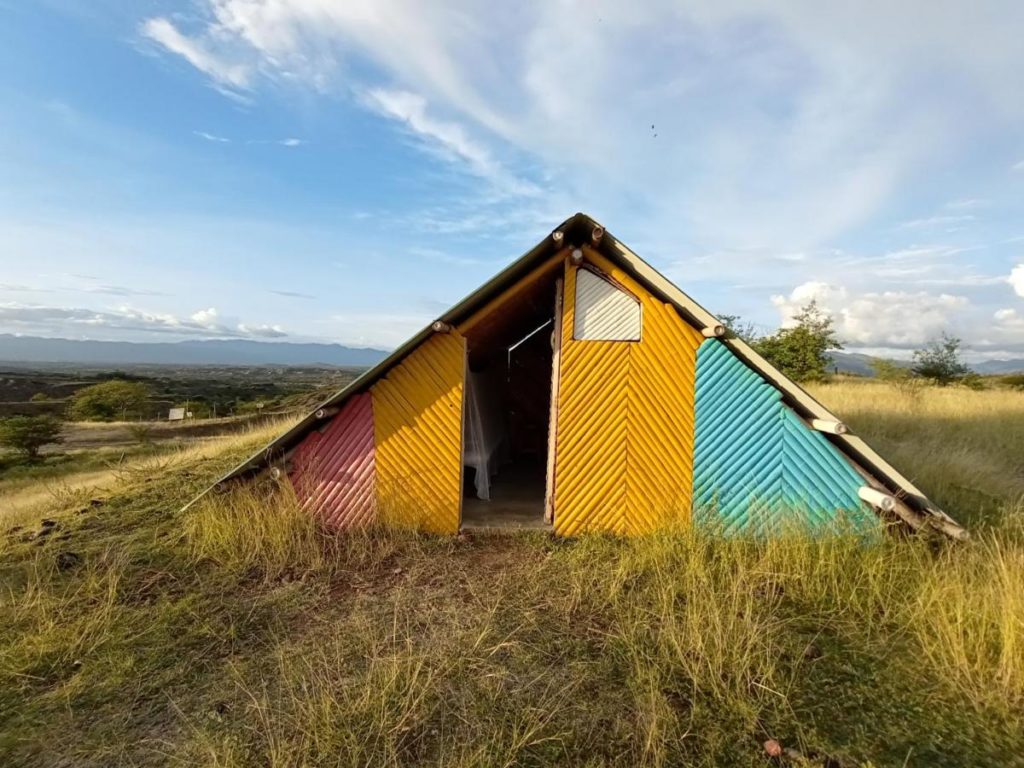
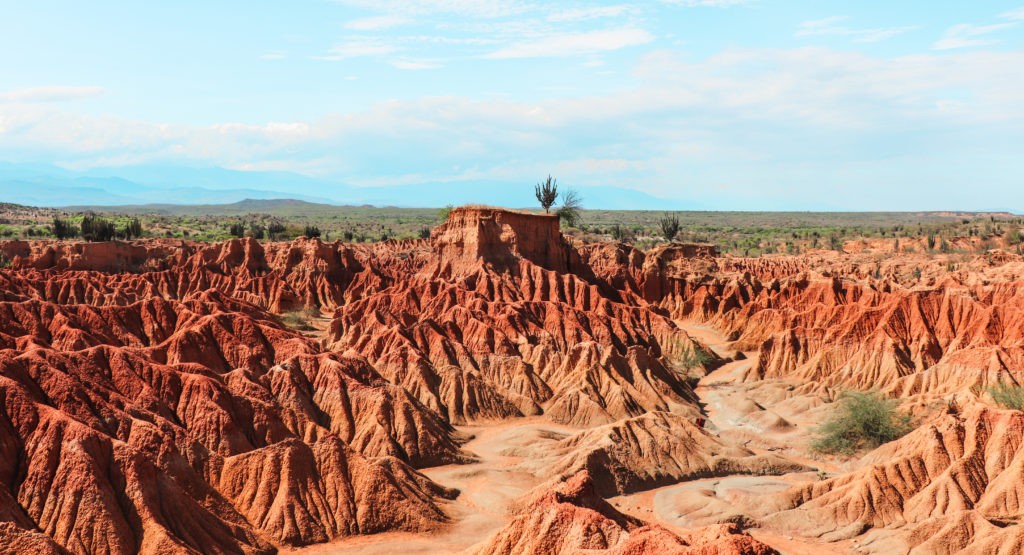
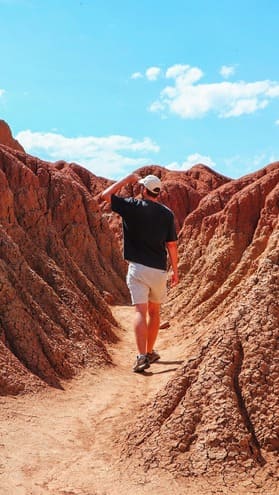
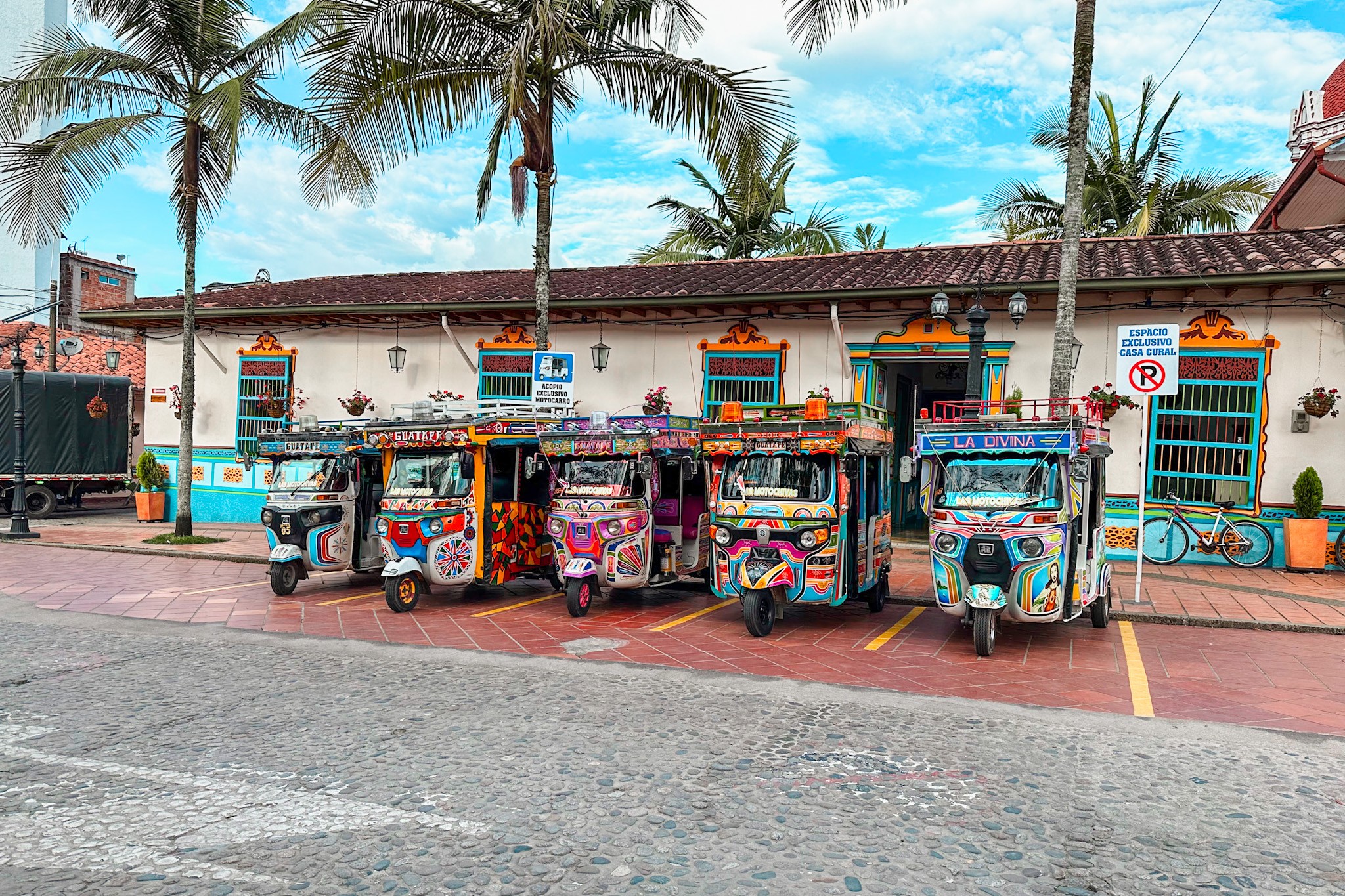
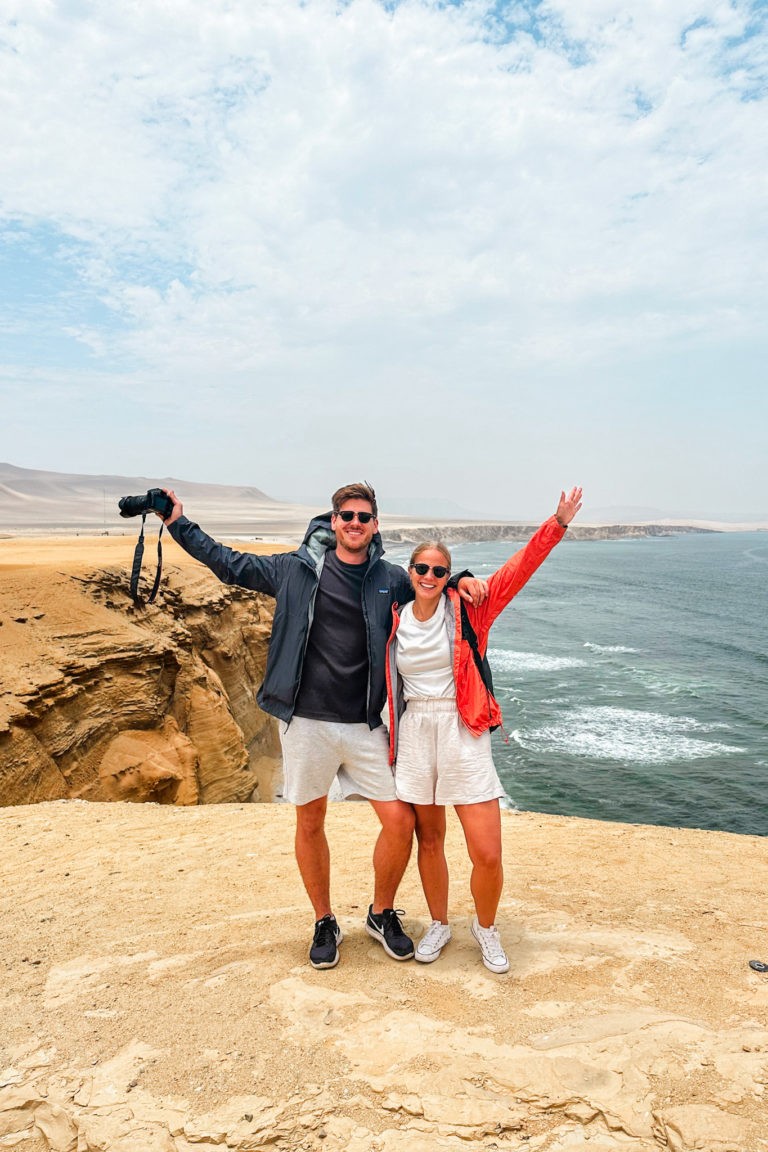

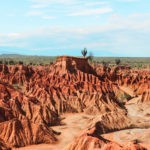
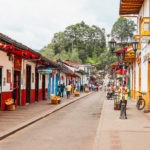
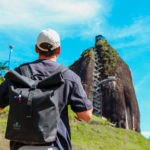


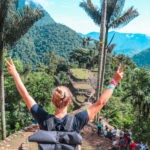


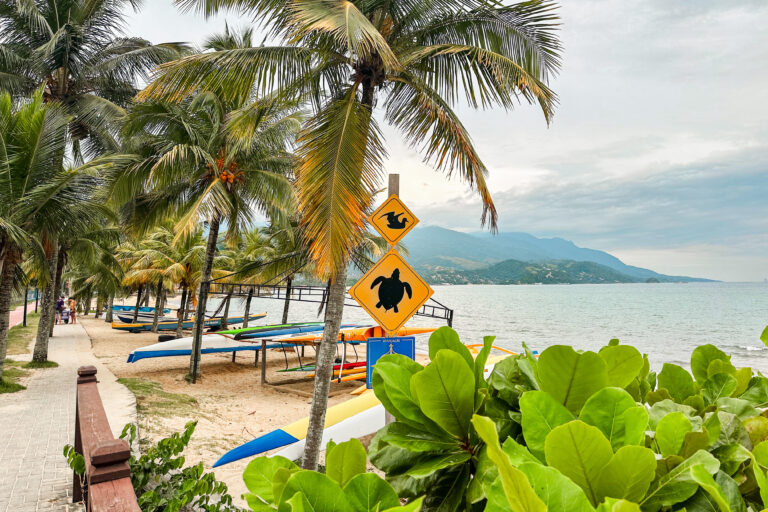
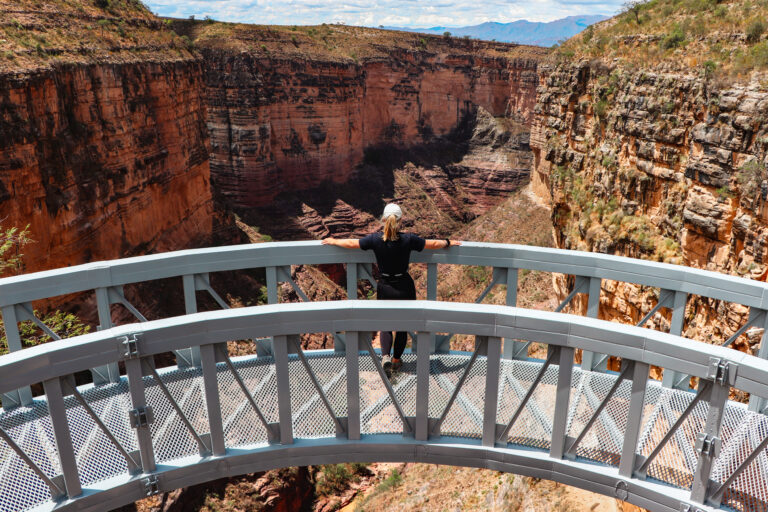
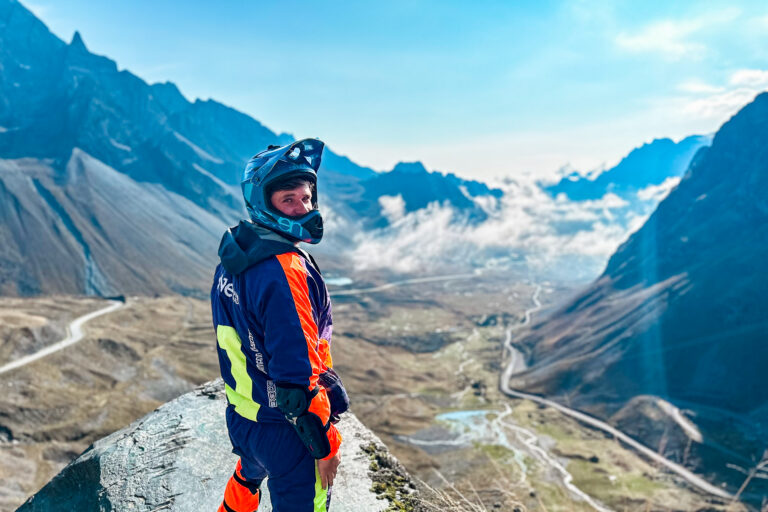
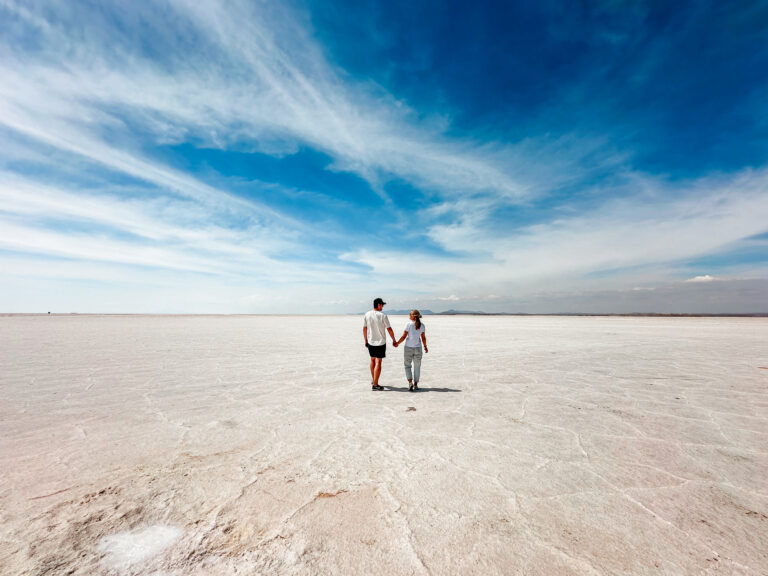
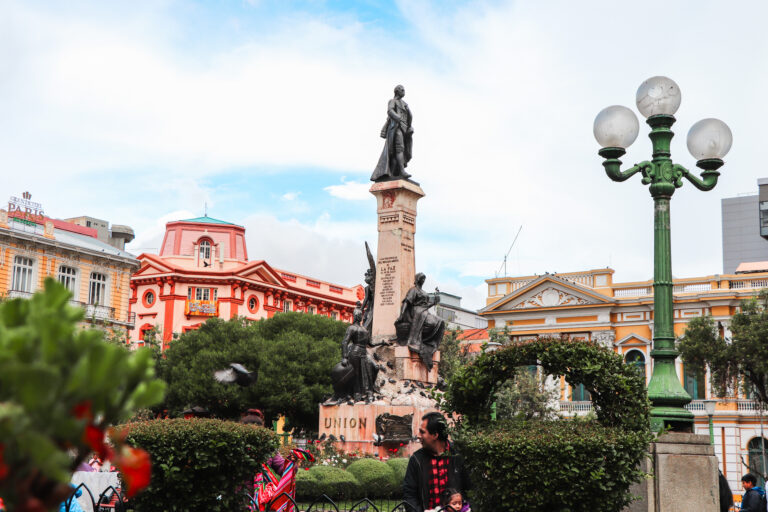
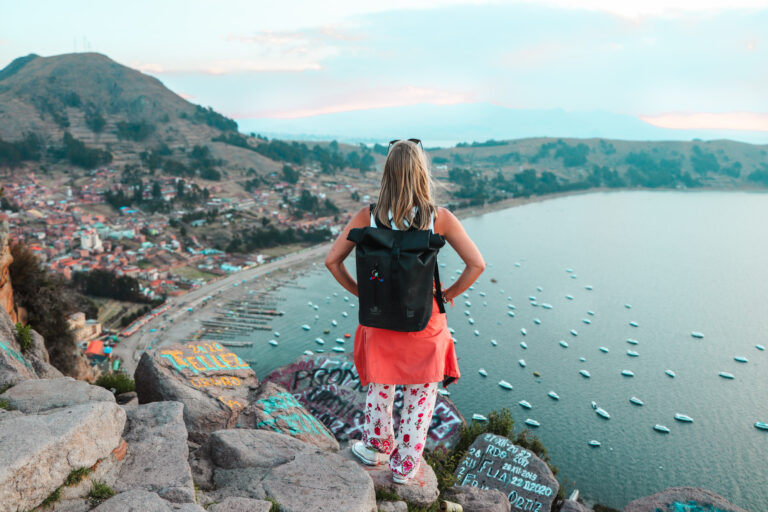
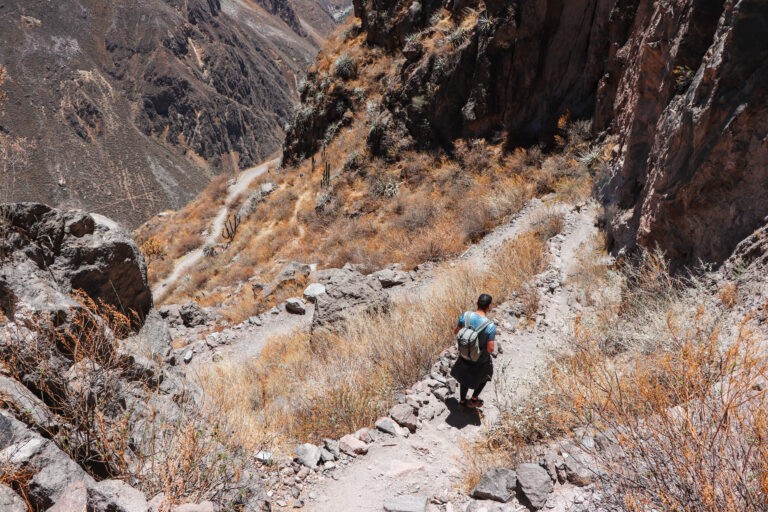
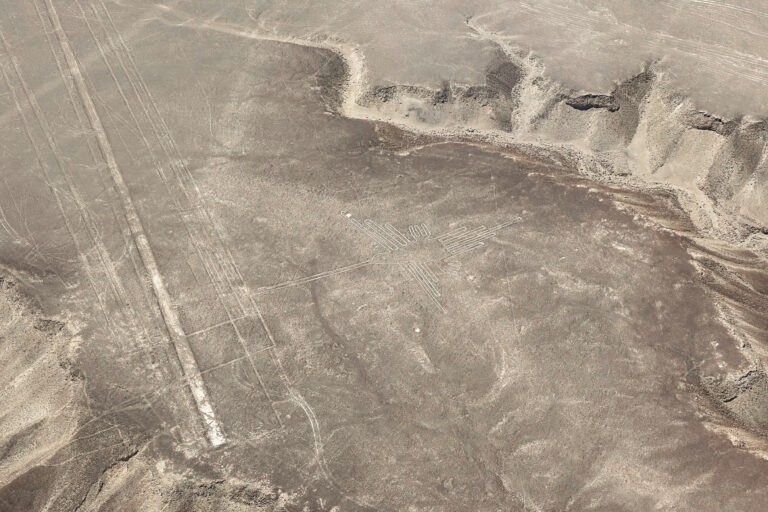
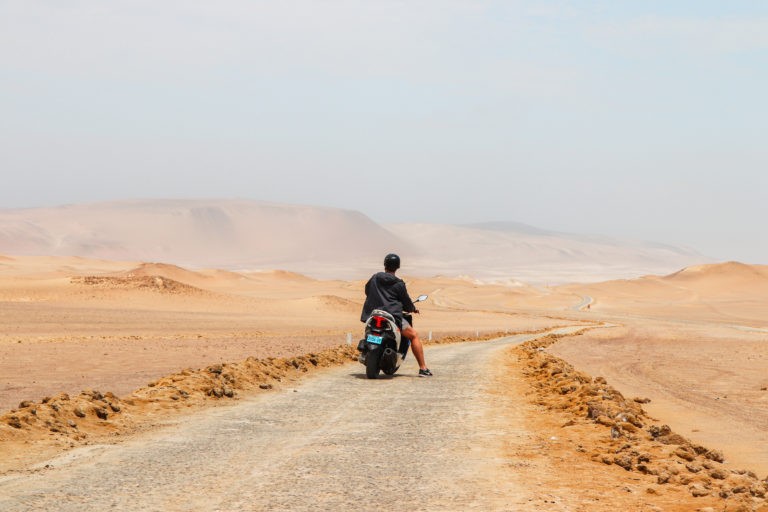
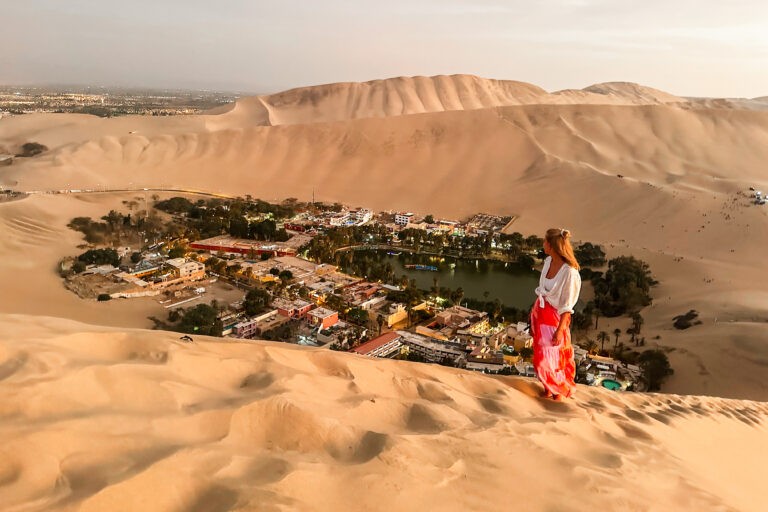

Amazing guide. Definitely have this on my travel list now. The quality of the site and your visuals are unreal. Keep up the great work!
Hi Andrew,
Thank you for this lovely feedback. Even though we put a lot of effort into our blog every day, “keeping up the great work” isn’t that difficult because comments like yours make it all worthwhile.
Happy travels,
Jens & Laura
Hi!
Do you have any contacts (locals) for visiting Tatacoa Desert? We are planning to go on April 1st, but I want to make sure that visiting is possible due to the weather. Would by nice to contact someone and discuss first.
I look forward to hear from you 🙂
Kind Regards,
Luka & Paul
Hey Luka & Paul,
super cool that you plan to visit the Tatacoa Desert!
You’re right, April falls in the wet season, so occasional rainfalls can happen. And when it rains, it’s most likely gonna be heavy. There are no official closure dates for Tatacoa, but if you’re unlucky the desert may be closed on the few days you will be there due to inaccessible roads. We would probably still take the risk and plan on going there as this place is just amazing!
We visited Tatacoa in August and hired a driver right from the Plaza, so, unfortunately, we don’t have a phone number for you. But what you could do is write to some tour operators and agencies in Neiva (the nearby larger city) via WhatsApp or reach out to the Backpacker Colombia groups on Facebook. We’ve had good experiences with both.
Wish you a great trip to Colombia, it’s a great country to explore, and let us know if there’s anything else you’d like to know!
Cheers, Jens & Laura